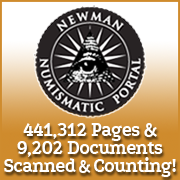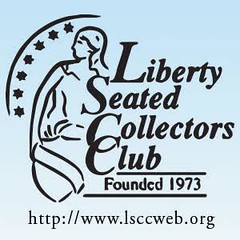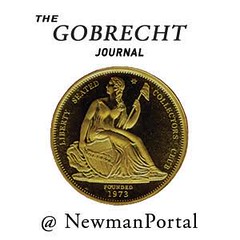
About UsThe Numismatic Bibliomania Society is a non-profit organization devoted to the study and enjoyment of numismatic literature. For more information please see our web site at coinbooks.org SubscriptionsThose wishing to become new E-Sylum subscribers (or wishing to Unsubscribe) can go to the following web page link MembershipThere is a membership application available on the web site Membership Application To join, print the application and return it with your check to the address printed on the application. Print/Digital membership is $40 to addresses in the U.S., and $60 elsewhere. A digital-only membership is available for $25. For those without web access, write to: Terry White, Treasurer AsylumFor Asylum mailing address changes and other membership questions, contact Terry at this email address: terrywhite5475@yahoo.com SubmissionsTo submit items for publication in The E-Sylum, just Reply to this message, or write to the Editor at this address: whomren@gmail.com
BUY THE BOOK BEFORE THE COIN |
- WAYNE'S WORDS: THE E-SYLUM OCTOBER 30, 2016
- COIN BOOKS AT THE WHITMAN BALTIMORE EXPO
- NEW BOOK: STANDARD CATALOG OF U.S. PAPER MONEY, 35TH ED.
- NEW BOOK: BANKNOTES OF DESTINY
- NEW PERIODICAL: NUMMUS CANADA
- BOOKSELLERS: ARMENIAN COINAGE IN THE CLASSICAL PERIOD
- KRAUSE PUBLICATIONS HISTORICAL MARKER UNVEILED
- NEWMAN PORTAL DIGITIZES LEVICK RUBBINGS BOOK
- WAYNE'S NUMISMATIC DIARY: OCTOBER 30, 2016
- DENNIS HENGEVELD ON NUMISMATIC LITERATURE
- NOTES FROM E-SYLUM READERS: OCTOBER 30, 2016
- VOCABULARY TERM: PROVING
- FRANK C. BEREK (1886-?), AKA FRANK BRIGHTER
- 1838-O HALF DOLLAR RESEARCH
- NEIL SHAFER'S COIN SHOP TALES
- RUSTY GOE'S SOUTHGATE COINS TO CLOSE
- CERTIFICATES EXCHANGED FOR SILVER IN 1960S
- THE BULLION CRISIS OF 2008
- PODCAST: PAT HELLER ON MINT AND COIN MARKET
- 1987 NGC “BLACK LABEL” HOLDER SOLD
- SLABBING ACID-TREATED DATELESS BUFFALO NICKELS
- COIN COLLECTING AND LOSING VISION
- NATIONAL COLLECTION ACQUIRES IBILL READER
- ALTERNATIVE CURRENCIES IN ANCIENT ROMAN WORLD
- WAR AGAINST COLLECTORS OF ANCIENT COINS
- QUEEN ANNE 'VIGO' GOLD FIVE GUINEA FOUND
- SOVEREIGN RE-CREATES ORIGINAL PISTRUCCI DESIGN
- THE DEADWOOD RACKETEER NICKEL
- SELECTED SCOTTISH BANKNOTES FROM PAM WEST
- POLYMER BANKNOTE INK EASILY ERASED
- IMAGES OF DENTISTRY ON PAPER MONEY
- THAI KING'S DEATH BOOSTS NUMISMATIC SALES
- VIDEO: TIME-LAPSE RESHELVING AT NYPL
- THE ANTHROPODERMIC BOOK PROJECT
- M. L. BEISTLE AND THE BEISTLE COMPANY
- FEATURED WEB SITE: ORIENTAL NUMISMATIC SOCIETY
Click here to access the complete archive
To comment or submit articles, reply to whomren@gmail.com
WAYNE'S WORDS: THE E-SYLUM OCTOBER 30, 2016
New subscribers this week include: Michael Rae, Philip de Jersey, and William Waychison. Welcome aboard! We now have 2,031 subscribers.
This week we open with updates on the Whitman Baltimore Expo, two new books and one new periodical. Other topics this week include J. N. T. Levick's Book of Rubbings, counterfeiter Frank Berek, M. L. Beistle, the 1838-O half dollar, Neil Shafer's coin shop tales, silver certificate redemptions, NGC "Black Label" holders, the Vigo gold five guinea, and Scottish banknotes old and new.
Time and space are the only things keeping me from including more great topics - there are some wonderful numismatic articles in recent publications such as The Numismatist , ANS Magazine and The MCA Advisory. If you're not already a member of the American Numismatic Association, the American Numismatic Society or the Medal Collectors of America, consider joining!
To learn more about Banknotes of Destiny, Nummus Canada, the Krause Publications historical marker, the Newman Numismatic Portal scanning center, Furioso plates, George F. Kuntz' Lusitania voyage, coin collecting sans vision, Pistrucci’s St. George and the Dragon, the Deadwood Racketeer Nickel and anthropodermic bibliopegy, read on. Have a great week, everyone!
Wayne Homren
Editor, The E-Sylum
COIN BOOKS AT THE WHITMAN BALTIMORE EXPO
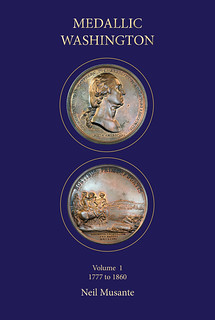 Numismatic literature dealer Charles Davis writes:
Numismatic literature dealer Charles Davis writes:
I will be at the Whitman Baltimore show Thursday November 3 - Saturday November 5. My booth (No. 1062-1063) has moved slightly from the usual spot against the back wall to the side wall nearby.
In addition to Neil Musante’s new work Medallic Washington, we will have a large number of new and recent titles published in the United Kingdom at a substantial 30-50% discount helped by the slumping £ Sterling. The November Baltimore is one of the best shows in the country and is extremely active in conjunction with the C-4 convention.
Author David Lange writes:
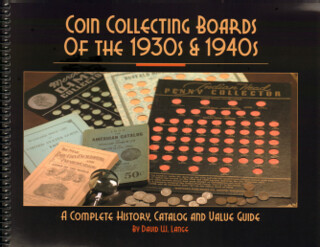 I'll have my PennyBoard Press books for sale at the Baltimore show. I may be found at the NGC booth.
I'll have my PennyBoard Press books for sale at the Baltimore show. I may be found at the NGC booth.
For more information on Dave's books, see:
www.coincollectingboards.com
Dave Lange's books include: Coin Collecting Boards of the 1930s & 1940s: A Complete History, Catalog and Value Guide, and Coin Collecting Albums - A Complete History , Volumes 1 and 2.
Neil and Dave's books are amazing high-quality productions. Be sure to visit Charlie and Dave at the show to see these in person and pick up copies. -Editor
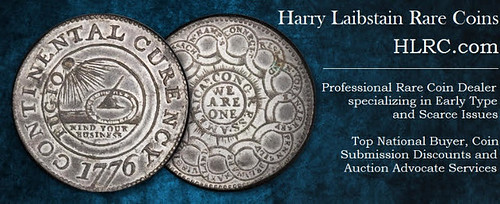
NEW BOOK: STANDARD CATALOG OF U.S. PAPER MONEY, 35TH ED.
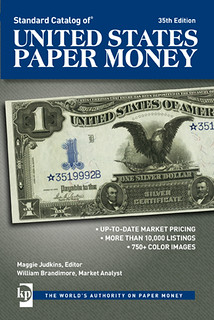 The 35th edition of the Standard Catalog of United States Paper Money, by Maggie Judkins, editor, and William Brandimore, market analyst, is now available.
The 35th edition of the Standard Catalog of United States Paper Money, by Maggie Judkins, editor, and William Brandimore, market analyst, is now available.
Featured in this invaluable catalog are more than 1,000 color note images, essential descriptions and real-world values in up to four grades for:
- Large- and small-size notes since 1861;
- Gold and Silver Certificates;
- National Bank Note by type;
- Pre-Civil War Treasury notes;
- Postage and Fractional Currency;
- Military Payment Certificates; and
- Error notes.
Perfect for novice and expert collectors alike, the Standard Catalog of United States Paper Money stands alone. No other reference contains the vast amount of images, type listings and price values as found here.
The 6” by 9” 480-page soft cover book retails for $32 (SKU R1313) from www.ShopNumisMaster.com.
For more information, or to order, see:
Standard Catalog of United States Paper Money, 35th Edition
(www.shopnumismaster.com/standard-catalog-of-united-states-paper-money-35th-edition)
To read the complete article, see:
SCUSPM in 35th edition
(www.numismaticnews.net/article/scuspm-35th-edition)
NEW BOOK: BANKNOTES OF DESTINY
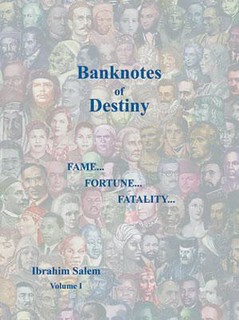 Researcher Ibrahim Salem has turned a 40-year hobby of collecting banknotes into a wide-ranging book documenting the history of Arab nations.
Researcher Ibrahim Salem has turned a 40-year hobby of collecting banknotes into a wide-ranging book documenting the history of Arab nations.
Salem, who describes banknotes as “the history of countries trapped in papers”, on Saturday launched “Banknotes of Destiny”, a book chronicling the major historical figures who have appeared on currencies and had an impact on their people and the modern world.
“In Jordan, we have five banknote denominations in current circulation. My collection has more than 500 Jordanian banknotes,” he told The Jordan Times.
Salem’s collection includes stock bonds, coins and the fees collected by governments at different times, as well as an archive of driving licences from different historical periods, manuscripts, maps, pictures of traditional costumes and passports from all over the world.
Salem has also accumulated a collection of all the Palestinian banknotes ever released, including the Palestinian 100 pound note.
The notes tell the story of the British mandate in Jordan and Palestine and the Israeli occupation of Palestine, he said.
“These banknotes are not for Ibrahim Salem, they are for the children of martyrs, and they are not to be sold no matter what. When I say martyrs, I do not only mean Palestinian martyrs, but all Arab countries,” he added.
The author says he is the first to analyse banknotes in this way, adding that most banknotes were released to commemorate events.
“I read history from my own perspective; what is mentioned in the [book] is from several sources and references,” he said..”
Salem, an architect by trade, says design has always been his first passion, but he wrote this book “to document events, figures and movements across the world, without expressing my personal opinion at any point".
"All the political and social figures that appeared on banknotes must have done something for their people, whether good or bad,” he said, warning that “those who do not read their history, do not know their future”.
To read the complete article, see:
Author says banknotes reveal stories, history of nations
(www.jordantimes.com/news/local/author-says-banknotes-reveal-stories-history-nations)

NEW PERIODICAL: NUMMUS CANADA

Trajan Media, the publisher of Canadian Coin News, is launching a digital numismatic magazine, Nummus Canada.
The new publication will be published every second month in both English and French, a first in Canadian numismatics.
“We’re hoping that this publication will help us reach an even bigger audience of money collectors,” said Mike Walsh, publisher of the new magazine, “and we’re quite happy that we were able to get an award-winning editorial team to lead this new venture.”
The award-winning editorial team he speaks of is Serge Pelletier and Steve Woodland, who, with Ron Cheek, were behind the extremely successful publication of the Ottawa Numismatic Society, moneta, which won three “Best Local Newsletter” awards from the Royal Canadian Numismatic Association and three first places in the “Outstanding Local Publication” contest of the American Numismatic Association, and this in the four years it was published.
“I’m excited to be back in an editor’s seat,” said Pelletier who is the editor of the new publication, “and I hope that our team, like in the past, will be able to provide great content for beginning and advanced collectors alike.”
While distributed electronically, Nummus Canada is designed as if it were a paper magazine and will be downloadable in PDF format. It will be launched at the end of the year.
Pelletier says the content in Nummus Canada will be different than the popular articles already featured in CCN.
The popular Trends section in CCN will not be included in Nummus Canada.
For more information keep an eye on Canadian Coin News website at www.canadiancoinnews.com.
THE BOOK BAZARRE
BOOKSELLERS: ARMENIAN COINAGE IN THE CLASSICAL PERIOD
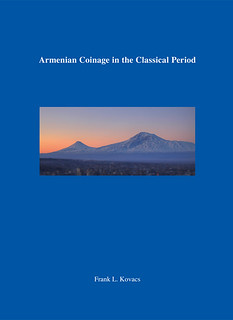 Frank L. Kovacs, Armenian Coinage in the Classical Period. 2016.
Frank L. Kovacs, Armenian Coinage in the Classical Period. 2016.
Classical Numismatic Studies No. 10. Lancaster, PA: Classical Numismatic Group, Inc.
Hardbound with dust jacket. 142 total pp., consisting of 25 pages of introductory material, 57 pages of coin catalog listings, and 34 plates of over 350 photographed coins.
The need for a revised and updated reference for ancient Armenian coins has been evident for many years. Publication has lagged, while long-standing misattributions have hampered the best efforts of classical historians. Armenian Coinage in the Classical Period addresses these problems, and presents many recent discoveries of previously unknown coins. Included are Sophene, Armenia Major, Commagene, Armenia Minor, and coins issued under Seleucid, Parthian, or Roman domination as well as contemporaneous pseudo-autonomous issues. The period covered is from earliest known issues of Arsames of Sophene, after ca. 255 BC, through the reign of Tiridates II, AD 217-252. Kovacs attributes or re-attributes coins to kings and queens to whom no coins were previously assigned, and identifies new dating eras and mints, and removes non-Armenian coins, fakes, and fantasies from the corpus.
ORDERS
North America:
http://www.cngcoins.com/Coin.aspx?CoinID=316022
Europe:
https://www.ma-shops.de/jacquier/item.php5?id=2538
To read the earlier E-Sylum article, see:
NEW BOOK: ARMENIAN COINAGE IN THE CLASSICAL PERIOD
(www.coinbooks.org/esylum_v19n32a06.html)
KRAUSE PUBLICATIONS HISTORICAL MARKER UNVEILED
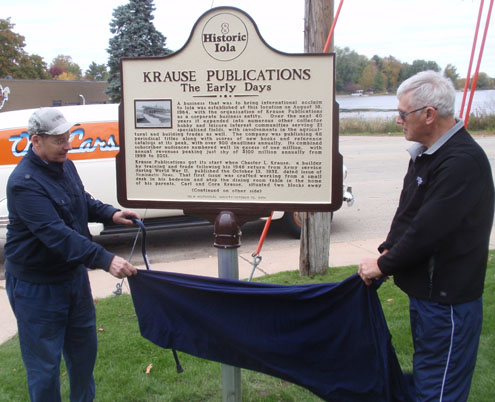
To read the complete article, see:
Jim Neiswinter, large cent researcher, asked if the Newman Portal could scan the Levick Book of Rubbings in the American Numismatic Society Rare Book Room. This is a fascinating document, a handwritten manuscript originating from the dawn of U.S. large cent die variety research. Levick’s investigation of the 1793 large cent varieties is of course most well-known from the Levick plate of 1793 large cent varieties in volume 3 (1868-1869) of the American Journal of Numismatics. Lesser known is this volume of pencil rubbings extensively annotated by Levick and presenting his analysis of the die pairings for this date.
While the Newman Portal is currently focused on American auction catalogs and archival material at the ANS, we will accept requests such as these and fit them in the scanning queue where possible.
Link to Levick’s Book of Rubbings
Link to Levick’s large cent plate in the American Journal of Numismatics:
My flight arrived uneventfully around 9:30am. Walking through the concourse I ran into John Feignbaum who'd actually been on the same flight after flying up to Dulles from Virginia Beach. He and his team of developers built (and continue to improve) the NNP web site.
I waited with John while he got a long-awaited cup of coffee from Starbucks. Together we took a cab to the campus of Washington University in St. Louis (WUSTL) where we were staying at the Knight Conference center. While John went off to visit with his son who is a WUSTl student, I worked to wrap up The E-Sylum in my room.
I took a break for lunch and walked several blocks to The Loop, a nearby commercial area. For grins I browsed through a retro record shop to see what kids these days are listening to on vinyl records. If I still had something to play them on I'd have bought a stack of old comedy albums - Woody Allen, Allan Sherman, you name it.
After a nice lunch at a barbecue place I took a picture of the Bakery for Dogs. If I'd had more time to kill I would have browsed through some of the art shops, which had some interesting pieces in the windows.
Dinner
Andy filled us in on some of the backstory around the Presidential Debate which took place at WUSTL's new gymnasium complex two weeks before. When the waitress asked if we were expecting another diner for the empty sixth seat, Andy told her "Donald Trump cancelled on us."
We had a wonderful dinner and talked about just about everything except NNP, from politics to the $240M WUSTL construction project, the transition of the Edison Brothers company and the history of the suffix -rama (from panorama to diorama, cyclorama, to bowl-o-rama and anything-o-rama).
Newman Numismatic Portal Team Meeting
The full meeting wouldn't start until 11, but we used the time to discuss priorities for new NNP web site features for 2017. In time the group grew to 14 people including Andy Newman, Chris Freeland, Robert Manley and others from the library staff, Newman Museum curator Tom Serfass, E-Sylum subscriber Peter Gaspar, a WUSTL Chemistry professor and numismatist. Peter was the first person to sign up after The E-Sylum was announced on the internet - he's been with us since September 5, 1998, and this was the first time we'd met in person.
Len gave a PowerPoint presentation outlining our progress over the past year and plans for the year ahead. While we'll continue to add content to the site, we'll also work to improve search features, social media connections and personalized content such as tags and lists of favorites. We're looking forward to discussing feature requests at next week's inaugural User Forum in Baltimore. The meeting concluded with conversations over boxed lunches.
Visiting Eric
Eric was as gracious as ever, telling us HE was the one honored to be visited by us. He told us he was pleased with the progress on the Portal. John's role in 2017 will be "Chief Storyteller". Len came up with that one - John will use his skills as a numismatic researcher to find, interpret and publicize research material available on the Portal. I joked that he'd better read fast, because there are already nearly half a million pages of material there. John laughed and thought he'd never run out of things to write about.
Other topics included the high schools we graduated from. Eric was the first student enrolled at his brand-new school, and he remembered one of his first chores there was digging a small trench to drain water away from a downspout.
His grandfather's framed pharmacy school diploma was nearby, and Eric recalled how he sold leeches from his store, where he slept on the floor behind the counter and got up to serve customers whenever needed, even in the middle of the night.
It was a short, but wonderful visit.
Before leaving Andy took this photo.
Scanning Center Visit
Digitization manager Robert Manley was there working to catalog some of the material. The scanning room was unusually empty and quiet. It was midterm season, and the students who typically man the machines were temporarily absent.
Len had made a trip to Eric's bank vault where some of his rarest books were kept. John and I had a ball examining them.
Outside the NNP office were many rows of movable shelves, and one section was reserved for the Newman Numismatic Portal. Here Len and John Kraljevich are reviewing some of the scanning pipeline material.
Len Augsburger writes:
Other holdings include ephemeral publications from the U.S. Mint, Bureau of Engraving annual reports, etc. This collection is by no means complete with respect to numismatics, but it is considerable, and physically located at the St. Louis scanning center, so this is low-hanging fruit for the Newman Portal.
The annual reports of the U.S. Mint director are another group in the library collection, and, with gaps filled in by Dan Hamelberg, Bill Burd, and Paul Hybert, we have a fairly complete run of this important series.
Heading Home
It was a short visit, but a reassuring one. The Newman Numismatic Portal project is firing on all cylinders.
Another specialty organization came to us offering their periodical for digitization Sunday night after dinner.
It's an exciting time. Stay tuned for more information throughout the coming year.
As noted before, the physical book is far from dead. New works are produced all the time, and may never become available online in any form. And there's no substitute for the original artifact - sites like the Newman Numismatic Portal are only collections of images. Numismatists want genuine coins, not pictures of them, and numismatic bibliophiles want genuine original books. The pictures can be useful, but are meaningless in themselves. An original Crosby or Maris remains a trophy acquisition.
This Coin Update article by Dennis Hengeveld published October 24, 2016 reiterates the case for books new and old.
-Editor
When you first start collecting coins you will often hear the saying “buy the book before the coin.” This is said for a number of important reasons. Knowledge is an important part of numismatics and the hobby as a whole, and acquiring that knowledge can help collectors make informed decisions, which in the end can save money. A coin collector who does not invest some of his or her collecting budget in numismatic references is like a car buyer purchasing a car without a steering wheel.
Since references are so important in numismatics the references themselves also hold value, and can be collected as a separate specialty. Numismatic books are somewhat different from other collectable books, of which the highest-prized editions are often the first editions. For numismatic (and other nonfiction) books this is not always the case. First editions, while interesting, often contain outdated information and are no longer good as a reference work. Only the most highly regarded standard works will hold premium value as a first edition, and sometimes an updated second edition can be more desirable than the first edition. The quality of the (photographic) plates can also be a factor.
As early as the 18th century, auctions containing ancient coins and medals (and often a variety of other items) were held in the United States; the first American auction dedicated to coins was held in 1813. Early catalogs lack photographic plates, and annotated catalogs that include prices paid and who the buyers were are in particular demand for their historical value. The value of these catalogs depends on a number of different factors, including the seller, the items offered, the quality of the descriptions, and the quality of the photographs (if present). Some collectors try to acquire all catalogs of certain companies, while others focus on catalogs of important collections.
Also collectable (although to a lesser extent) are fixed price lists from noteworthy dealers. In the time before the Internet these were often an important source for collectors to acquire new coins, and the fixed price lists can give a good impression of the coin market at the time. Again, those containing special and/or advanced collections will be more in demand than others.
Of course, numismatic reference works on particular subjects are important as well. One specialty that is very popular is books focusing on early American large cents; many of these are among the earliest specialized works on American numismatics. A dedicated collector of large cents could spend a small fortune on first editions of works related to their collecting field. To a lesser extent this also true of books on American colonial coins and other numismatic areas.
A collector interested in older works will have to cross the pond, where the earliest numismatic references were published hundreds of years before the Philadelphia Mint struck its first coin. Many of these works are related to ancient coins, a subject on which thousands upon thousands of books have been published over the centuries. Medieval coins follow, and some reference works published as early as the first part of the 18th century still count as the standard works in their particular fields of study. (Dutch historical medals come to mind, with the Van Loon reference published between 1723 and 1731 still being regarded as the best work and, as such, remaining in high demand).
With so many numismatic books and auction catalogs issued over the years it would be virtually impossible to list all the major works in this article. However, numerous reference works have been published that list major auctions, numismatic books, and other reference works that can prove to be an important starting point for the collector interested in building a library that goes beyond the basics. And for students of numismatics and numismatic literature, the Numismatic Bibliomania Society and its free e-newsletter, the E-Sylum, are crucial resources.
As always, condition is important if you’re seeking the book as a collectible object—but don’t forget that the books contain important information that might not be found elsewhere, especially if the person who wrote it was in attendance at a sale or was a well-known numismatist.
To read the complete article, see:
Wait, Wait, Don’t Tell Me!
I am a proud subscriber to The E-Sylum and would like to thank you for creating such a wonderful publication. I look forward to the next issue every week. I enjoyed the recent “Wait, Wait, Don’t Tell Me” quiz. I am proud to say that I got four correct! I got lucky!
To read the earlier E-Sylum article, see:
Furioso Plate
I've seen (and probably even used!) the term "Furioso Plate" for an engraving that is almost panoramic in nature, extending the entire width of a note. Can anyone confirm that this is the correct term and its origin if it, in fact, exists? Thanks!
George F. Kuntz
I happily noted the mention of this gentleman in several recent issues of E-Sylum. The E-Sylum entries spell it Kunz, as does his Wikipedia page, but it’s a not uncommon variant, either way.
You may recall my fascination with the Lusitania medal (heck, I wrote a book on it). During my research I purchased a reply letter dated 1915 written by Counselor Robert Lansing of the US State Department (later that year to become secretary of state under President Wilson) to Kuntz acknowledging a letter Kuntz had written to the state department.
Kuntz had been on board the Lusitania when it departed New York on January 30, 1915, traveling to Liverpool. This particular trip was rather noteworthy and controversial because several passengers (Kuntz and President Wilson’s confidant Colonel House among them) noted that the Lusitania’s Captain Dow hoisted the US flag as the Lusitania drew close to the Irish coast as a deceptive guard against any lurking submarines (the eventual instrument of destruction of the Lusitania later that year). The press had a bit of a field day with the action, and Germany sharply decried the fraud as well.
German medallist Karl Goetz produced one of his many famous satirical medals denouncing the British practice (K-165, Abuse of Neutral Flags), and Wilson protested to the British, though not very vigorously. When he returned home Kuntz wrote his own letter of complaint, receiving this reply from Lansing: “Sir: The Department acknowledges the receipt of your letter of February 18th, and in reply informs you that your remarks relative to the use of the American flag by foreign powers, has received the attention of the Department…”
Kuntz/Kunz was obviously one unafraid to express his opinions, not unlike Karl Goetz. One wonders what either of them today would think of the pending US election
As always, I greatly appreciate and admire your prodigious devotion to your weekly publication. It’s a treasure in the hobby.
To read the complete Yale collection entry, see:
To read the earlier E-Sylum articles, see:
Lead proofs – also called Die trials or Lead impressions – are made while the die is still in a soft state capable of any retooling. The soft metal blank is always larger than the die and thicker than a normal blank. It can be the device alone or the completed die as shown here.
Proving.
Testing dies before they go into production. No matter whether a die is cut by hand or by machine, it is always useful to examine the die at each stage of production, often before it is cut any further, absolutely necessary before the die is hardened and before any items are struck from it. Thus proving occurs when the die is still capable of being improved – that is, while it is still in a soft state and further cutting can occur.
Proving hand engraved dies. Hand engravers like to examine the state of the die at frequent intervals while they are working on it. This is unnecessary for CAMEO DIES, since the hand engraver is cutting in the positive, but the engraver must frequently examine a negative die. This can be done with a quick impression in very soft material – wax, clay or plasticine – a ball of such plastic material is pushed into the negative relief while the die is still locked in the vise at the engraver's bench.
If the engraver cannot get as sharp of an impression by pressing the wax or clay into the die cavities by hand he would place a block of wood on top of the soft material and direct a hammer blow to the wood block. If he wanted to keep the wax or clay from sticking to the die would dust a little graphite on the steel surface first. If the wax or clay impression is not as detailed as the engraver desires he may opt for an impression in soft metal.
Soft metal proving. In years past engravers would make a SPLASHER or a HOT TIN IMPRESSION, often right at their workbench. The soft metal would be heated, a small amount of melted lead, tin or pewter would be poured onto scrap paper lying on a flat surface (we still observe newspaper stuck to the back of 100-year-old splashers today). The die would be taken from the vise and pressed by hand into the molten and somewhat fluid metal. The impression – sharper than one in wax or clay – would present more distinct detail to the engraver.
Handcut dies could also be proved on a small press – creating a DIE TRIAL. Large firms would have a special press reserved for this purpose – smaller firms would utilize any press not in use at the moment the engraver wanted a struck proof. A hand press could be used or one which could greatly regulate the pressure.
A fairly thick blank of soft metal – always oversize – would be used with a die still in the soft stage. Thick blanks would be used not to damage the die; too much pressure, or too hard a blank, or too thin a blank could cause the die to sink or disfigure. Soft lead or tin blanks struck with low pressure could create a satisfactory die proof image at this stage.
The die proof would be examined and if the die required some further work, it could, of course, still be engraved in the soft state. If the die was cut properly – with all its intended relief and with the high points intact – it would thus be acceptable. The die would then be hardened and could be placed into production.
Proving machined-cut dies. In present day practice, experienced die cutting machine operators examine the die under magnification perhaps as often as hand engravers examined soft metal proofs. Each step of production must be satisfactory before going on to the next step. For machine- cut dies this would occur after each pass or each cut. While the die is locked into position in the diecutting machine a soft material impression could be taken, like the hand engraved die, in wax, clay or plasticine. This impression would be closely examined to see if all the detail was cut properly or whether another cut is required. See PANTOGRAPH.
Customarily a die is removed from the diecutting machine after three separate cuttings and then a lead proof is made on the proof press. Such an impression is also called LEAD IMPRESSION or LEAD CLICHE'. Dies are always proved one at a time. They are locked in the proof press, a thick oversize blank is positioned in the press and the press is set for a very low pressure squeeze. The pressure may be increased until a satisfactory impression results.
Again, the thick planchet of soft lead or tin is used to protect the soft steel die. The thick planchet acts as a cushion for the soft steel. The soft metal proof is examined and if the die is acceptable it is hardened for production.
This is a stub of a much longer entry on proving. The remaining entry discusses: Lead, tin and reused metal, Die trials and Nonmetal proofs.
"the workmanship of the counterfeit bills is of the highest order, the red silk lines in the back being imitated perfectly by the use of ink. The paper and printing are first class, and the vignette of Franklin on the face of the note is of such a character that it would disarm suspicion anywhere. The quality of the work is indicated by the fact that one of the bills was presented to two banks in San Diego, and after a critical examination the bank officers were not willing to declare that the bill was bogus."
No newspaper notice appeared subsequently informing the public he was captured. No further information about Frank Berek has been found. Anyone with any information of the whereabouts of Frank Berek please inform, no, not the police, I'm sure he passed away by now, but rather, write me or Wayne Homren, editor of the E-Sylum and post what you have.
John adds:
He changed his name so frequently it is hard to trace him out. I could not find any newspaper article resolving the case that he was finally caught and sent to prison.
To read the complete article, see:
NEW RESEARCH PROVES THAT THE TYLER/BACHE SPECIMEN
In January-March 2016, NGC conducted an exhaustive out of holder examination of the TYLER/BACHE 1838-O half dollar.
It is one of only nine known specimens, and the purpose of this review was to determine if it had characteristics that made it different from the other eight.
SUMMARY OF RESEARCH FINDINGS
1) The Tyler/Bache specimen has the least developed GR-1 die crack on the reverse and it is therefore the earliest produced of all the known survivors.
2) The Tyler/Bache specimen has dentil distress marks on its lower reverse that were made by the loose reverse die at the end of the Jan1839 original (first) production run. This run was intended to test the large dollar press in order to make coins for circulation, but the reverse die support system collapsed after only 10 coins were struck, and it was not possible to make more at that time.
3) No other specimens have even the slightest reverse marks that could be attributable to the loose reverse die. These marks would have to be present if the others were produced in this same run because they were all struck later than Tyler/Bache and have more developed GR-1die cracks. Therefore, Tyler/Bache MUST BE THE ONLY SURVIVOR FROM THE ORIGINAL RUN.
4) The Tyler/Bache specimen has a weak/shallow strike. This weak strike is due to two factors. First, the coins in this original run were intended for circulation rather than as proofs for the Mint Director. Second, the original run had to use the dollar press because the half dollar press was not ready for production. The reverse half dollar die was too short to be secured into the larger dollar press, and Rufus Tyler, the Chief Coiner, had to splice it into place. We can infer that Tyler would have used lower striking pressure on his "jury rigged" system in an attempt to reduce the risk of failure.
All the other specimens have very strong, sharp, strikes that are stronger than even the PROOF 1838 half dollars made in Philadelphia. We can conclude that these other specimens COULD NOT HAVE BEEN MADE ON THE DOLLAR PRESS AT A LATER DATE because their strikes are too strong.
5) All other specimens are PROOFS Produced at a later date on the half dollar press for Mint Director Patterson.
OVERALL CONCLUSION
All known 1838-O half dollars fall into two groups. They are :
ORIGINALS
PROOF RESTRIKES
For the full text of the research study, please click on this URL. Please note that Dropbox will ask you to sign up, but this is not necessary. Just click on "skip this step":
Few American coins have a history and rarity that can equal that of the TYLER/BACHE half
dollar. In the 19th century the origins of the 1838-O half dollar were unknown, as there were no mint
records of its production. As late as 1890, some numismatists believed that no more than 3
specimens existed, and it was considered to be among the rarest of all American coins.
Then, on June 7/8
1894, Ed. Frossard held an auction of the William Friesner collection in New York and an 1838-O half
dollar was listed as item number 583. The coin was purchased by famed Numismatist and author
Augustus Heaton, and his initials can still be seen next to the listing in Frossard's personal copy of the
auction catalog. Heaton had published his book "A TREATISE ON COINAGE OF THE UNITED 1
STATES BRANCH MINTS " in 1893 which led to numismatic interest in the collection of mint marks in
addition to dates, and the 1838-O half dollar was prominently referenced in his book on pages 28 and 29.
After purchasing this prized item, Heaton made inquiries as to its origin. As a result of these inquiries, a
note from Rufus Tyler, Chief Coiner of the New Orleans Mint, was discovered, and this was the first clue as
to the origins of this famed rarity.
The various letters about Chicago coin shops intrigued me since I, too, went around to many of them as a youngster in the mid-1940s. Here's whom I remember: On Saturday after my violin lesson I would tuck the case under my arm and hop the streetcar to the Loop, as downtown Chicago is known, was not far from where I had the lesson. I went to Ben's Stamp and Coin where Harlan Berk is now and went through the dime box of world stuff, always finding a few I wanted.
On south Dearborn there were some- L. Ronning was a favorite as he had great stuff in his misc. boxes, James P. Randall was not much of a place for me as he had such high-priced things in his window like early U.S. gold. I recall Lou Castelli, I believe upstairs somewhere. Leonard Stark was one I met somewhat later as I believe he was not among the earlier dealers there. Tommy Ryan and John G. Ross were others that I believe I also met later on. There was also Bebee on south 63rd street but I never got out there while he was in Chicago.
Krasowski at Kraso Coins way out on 95th St. used to attend some sort of meetings - maybe it was Chicago Coin Club, which Dick Yeo, Ken Bressett and I used to go to regularly. Those were fine meetings with many of the stalwarts that occupied the Chicago numismatic arena for years.
There was someplace upstairs that was run by some older folks. I don't remember their names but I do remember and still have the first shield nickel I ever owned. It has a hole, some strong bumps and dents that took away most of the date, but some details are not badly worn,- and I was simply delighted when they gave it to me free. I just stared at it in amazement- a real shield nickel, and it was mine!
The All-Nation Hobby Shop was another place that had interesting items. I had learned someplace that Confederate notes had different redemption times. I had a 2-year note and wanted to get a 6-month piece to go along with it. (I did not know of the 1-year notes yet.) All-Nation had a selection of Confederate pieces but they wanted 75c or $1 and I wanted one for 50c as I had a very limited amount of money. So I looked through the notes and finally found one in fairly decent shape, a $5 of 1861, for the 50 cents.
Many years later, after I traded it off for something else, I found that it was among the very rarest issues! The old classification was Bradbeer 221.
On another street there was the store of H.L.P. Brand (Horace Louis Philip). Little did I know that he was the brother of famed collector Virgil Brand, and that the items he was selling were most likely from that great collection. He was some old fellow and I did not go there a second time.
Yep- those were the days when everything you ever wanted was available and not very costly either.
To read earlier E-Sylum articles, see:
Rusty Goe said that he and his wife, Marie, had not planned to close their store on South Virginia Street in such an abrupt fashion, but that they had little choice.
Marie Goe said that if a perfect retail-space somewhere on South Virginia Street’s southern corridor had become available, she and her husband would have considered setting up a new store.
“But since we are already near retirement age it doesn’t make sense for us to go to all the trouble and expense to set up a new store,” she said.
She said it takes considerable effort and cost to build out a coin shop that would replicate their current store.
“Just to have the basic facilities we have now, with all the security systems (and safes) we need, so we could provide our customers with the services they have come to expect would require a substantial investment of time and money on our part,” she said.
“When we were younger we met such challenges with vigor; but now we aren’t as adventurous,” she said.
The Goes moved their rare-coin business from Las Vegas to Reno in 2001. Marie said it took months to find the right location for their store in Reno and that the process of building out their store to meet their needs “was exhausting.”
Business soon increased beyond the Goes’ expectations, they said, and within three years of establishing their Reno site they more than doubled the size of their store.
A remodel in 2004-05 took five months, and was “very costly,” said Marie. “But we were happy with the results.”
The Goes said they would have preferred to work in their existing coin shop until 2021, their shop’s 20th anniversary. By then, they would have tried to find a buyer who could have taken over the business.
The Goes said they are uncertain as to what extent they will continue their business once they vacate the shop at the end of November.
“We still have our website, and the hundreds of customers we have can follow us on it,” he said.
Rusty Goe said he will pursue his research projects and do more writing. He has already published two books that have received awards from numismatic groups: “The Mint on Carson Street,” a history of the Carson City Mint and guide to the coins produced there, and “James Crawford: Master of the Mint at Carson City,” a biography of the longest-serving superintendent at the Carson City Mint. He is currently working on a third book, “The Confident Carson City Coin Collector.”
In 2005 he founded the Carson City Coin Collectors of America, a club dedicated to increasing knowledge about the Carson City Mint and the coins produced there. This club published a journal called Curry’s Chronicle from 2005 through 2015, for which Goe served as editor. Goe has also written articles in national and local publications and presented lectures both locally and across the country.
To read the complete article, see:
Intermediate paper money collectors have learned that certain classes of 19th century American notes have different legal redemption clauses. Advanced collectors who also happen to be lawyers may fully understand all of the fine print regarding tariffs and duties. Normal collectors — normal people — do not! And for that matter, don’t care — and never have.
But for less than half a decade, coin and paper money collectors alike were focused on the “fine print” of silver certificates, especially when profits could be made without guilt or great difficulty. It was, perhaps, the most interesting four years since the U.S. government began issuing silver-backed notes in 1878.
The silver certificates of the nineteenth century were made fully redeemable in silver dollars — and with this complete convertibility, the paper money was a perfectly acceptable substitute.
When the size of American paper currency was reduced (from “large size” to “small size”) in 1929, the federal government technically made silver certificates even more desirable, by making them payable in any silver coins — and again, no one needed to care. Redemption of paper for silver was a moot point, as long as one dollar’s face worth of silver coins contained less than a dollar’s worth of silver metal.
For that matter, the silver certificates circulated alongside Federal Reserve notes and United States notes in the 20th century, and no one cared except collectors interested in even more attractive notes. For most of the public, coins were heavy and annoying. In 1960, when I began collecting coins, I liked silver dollars, but it was because they were historic and heavy!
The price of silver was about 90 cents an ounce (and the coins were made of 90 percent silver and weighed less than an ounce), so convertibility was more a theory than a practice.
Then in 1961, everything began to change — for collectors and for the wider public. In 1961, the price of silver closed above $1 an ounce. The intrinsic value of a silver dollar was still less than $1 (as they do not contain an ounce of pure silver), but the Treasury grew concerned. Industrial and jewelry uses of silver were growing faster than mining, and the consequent production deficit forced prices higher.
In November, President John F. Kennedy issued an executive order suspending further sales of government silver, and starting the retirement of $5 and $10 silver certificates. Silver continued its record appreciation, hitting $1.28 on March 13, 1963. By summer, it reached $1.29. Coin dealers smelled blood in the water. Then collectors noticed, too, followed by the public.
The government had to do something. On June 4, 1963, the Silver Purchase Act was repealed, and the issuing of silver certificates ended. Federal Reserve notes would become the currency of America, including a new $1 denomination.
The government agreed to continue to redeem silver certificates with unspecified coins (any silver denomination), and critically, to continue to redeem them for silver dollars when presented at the cash windows of the Treasury Department. For decades, the Treasury had largely unsuccessfully tried to get rid of its silver dollars; its wish was about to come true...
1968 was before my time as a collector but growing up in the 1970s I could still find silver coins in change occasionally. I could even talk cashiers in neighborhood stores into saving silver coins for me for exchange at face value. Friends and neighbors would often ask me if their Silver Certificates were worth anything, but by then they'd missed the boat - the laws had been changed. Only the coins had any intrinsic value.
We've published stories before from the later era of silver dollar bag sales. Were any of our readers active in turning in silver certificates for coins? Let us know your stories.
-Editor
To read the complete article, see:
“It still baffles me that we can’t make a planchet. . . . Isn’t this just pretty simple? This just really is confusing to me why this can’t be accomplished. . . . What would a businessman do about this? Would he always resort to going to Australia to do this? It just seems so bewildering that a problem that seems rather simple, that we couldn’t have had an easier solution for this.” *
It was July 20, 2010, and I was a witness in a congressional hearing. The powerful United States House of Representatives Committee on Financial Services Subcommittee on Domestic Monetary Policy and Technology was meeting. We were in room 2128 in the Rayburn House Office Building on Capitol Hill. The four of us on the first panel of witnesses represented all the executive branch’s key officials with direct responsibility over U.S. coins, currency, and anti-counterfeiting measures.
The Honorable Ron Paul (R-Tex.) was staring intently at me, waiting for my answer. At the time, he was the ranking member of the subcommittee. His gaze down at me was made all the more serious from his perch. He was sitting next to the subcommittee chair on the fourth and highest level of seating in the committee room.
What is the journey that one takes to be the focus of a congressional oversight hearing? For me, that journey had begun 29 months earlier.
It was February 2008. I was sitting in my office at the U.S. Mint headquarters building. We were near Chinatown at 801 9th Street, NW. I was director of the Mint, and my large office was in the southwest corner of the building. Standing in front of me was my number two, deputy director Andrew D. Brunhart.
Andy and I were alone. It was his habit to give bad news to me straight, quickly, and privately.
“Sir, a spike in demand wiped out our inventory of silver bullion coins. It will take us awhile to make enough to meet demand. In the meantime, we will be in violation of the law,” he said.
Those words sent a bigger chill up my spine than was justified by the relatively mild temperatures of the winter we were having.
I asked what the immediate consequences were.
“Dan says there are no prescribed penalties for being in violation of the law. But he’s pretty clear about the urgency to get back in compliance.” Dan Shaver was the chief counsel to the U.S. Mint. “Cliff says that if Congress gets enough complaints from angry constituents, both Senate Banking and House Financial Services might have an oversight hearing to rake you over the coals.” No truer words had ever been said. (Cliff Northup was the Mint’s director of legislative affairs.)
“Well,” I asked Andy, “what’s the plan to keep me out of jail?”
To read the complete articles, see:
PH: I was a little bit suspicious because sometimes a bureaucracy will have made a decision on what they are going to be doing and they hold an event like this to provide cover to pretend it wasn’t all their planning… but the impression I got and with the other I talked is that the people at the U.S. mint really were seeking legitimate outside feedback on how they do things… which is a positive thing. They started out the program explaining the history of the Mint, how the National Numismatic Collection came to be formed at the Smithsonian, and in the process pointed out some of the constraints they have, such as a lot of authorizing legislation for coins specifying the weight and purity of coins and sometimes even the designs, so there are limitations on how much flexibility they have- but once we had that background, they broke us up into groups to talk about different smaller picture issues and reconvened to go through what each of us had come up with on particular subjects, so there was a lot of good stuff raised.
One of the thing I was a little concerned about is that where the U.S. Mint is trying to sell primarily to the ultimate collectors, there is a natural conflict of when it sells to coin dealers – does it charge the same price as the public pays, which would discourage dealers from wanting to buy products and resell them, or does it discount them to dealers and possibly run the risk as has happened with some discount programs in the past, where dealers then price the products below what the mint is charging and potential take customers away from the U.S. Mint. That was an issue that wasn’t really brought up at all.
CM: As a coin dealer, obviously, the Mint is asking you for your advice on how they can better compete against you. It seems to me that the Mint is doing a fine job already of competing against the traditional rare coin market. Wouldn’t you say?
PH: There is that kind of conflict as well. Most collectors, just about all of them, in fact have a limit on how much they can spend and if you are spending a certain part of that budget or maybe, even all of that budget buying from the U.S. Mint direct that leaves less for other coin dealers. So there is the potential that some coin dealers may knock buying merchandise from the U.S. Mint in order to try to get more customers to shop with them.
That can be influenced if you have a situation such as has happened now where, I’d say the majority of U.S. Mint issues in the last 20 years, numismatic issues are now trading for below their issue price, so that would make it easier for coin dealers to knock buying new issues as they come out… and the ones that and the ones that have gone up in price have not gone up by enough to offset what has fallen on the other pieces.
To listen or read the complete transcript, see:
Collectors keep loving slabs. Third-party grading has brought enhanced transparency, liquidity and confidence to the rare coin market. Perhaps in recognition of this, collectors covet rare encapsulations from grading firms, especially Professional Coin Grading Service and Numismatic Guaranty Corp., and these unusual slabs have become collectibles in their own rights.
At a Sept. 18 auction by GreatCollections, the online auctioneer sold a 1946-D Walking Liberty half dollar graded Mint State 65 by NGC for $3,740. For reference, a normal Gem Uncirculated example of this date sells for around $100, nice MS-66 examples can be found easily for $150 and MS-67 examples routinely sell for around $1,000.
What made the brilliant half dollar special was that it was housed in an old “Black Label” NGC holder that was used by NGC only between September and November 1987. The coin’s orientation in the slab is different than what collectors expect today in that the identifying label is placed on the reverse side while the gold NGC logo is on the obverse side.
To visit Dave Lange's Coin Collecting Board site, see:
www.coincollectingboards.com
To read the complete article, see:
To read earlier E-Sylum articles, see:
If you are of a certain age, you can recall encountering many of them in change.
Though they did nothing to help fill a Whitman album in the circulation finds era, they often sparked daydreams as collectors wondered what dates might have been on them.
If this describes your early days as a coin collector, a “Numismatic News” reader who does not want to be identified has suggested that the many dateless Buffalo coins that are still around can take coin collectors down memory lane.
As he wrote in an e-mail, “I have found a way to enjoy coin collecting today with much of the fun as I had in looking for coins for my albums when I was a youngster back in the 1950s.”
As you might have guessed, he then extolled the virtues of using date restoring acid on them.
“I have been acquiring quantities of dateless Buffalo nickels over time and have been successful in almost completing a set of 1913-1938 Buffalo nickels. What has caught my attention is that these unwanted 100-year-old coins are worthless among most coin dealers and many collectors,” he wrote.
While acid treatment has been around almost as long as the dateless coins themselves, the reader points out something that is less well known.
“Many do not understand that PCGS, NGC and ANACS will encapsulate these coins and attribute varieties.”
“Through my many searches, I have been able to secure an acid treated 1916 DDO (doubled-die obverse) nickel and a 1918/7-D overdate example. I believe that there may be a bright future for these discovered coins at very reasonable prices.”
To read the complete article, see:
I am a more or less regular E-Sylum reader in the last year or so.
I'm writing to you regarding comments by Ann Williams in the last issue:
"The family of Alexander Zaika would like to extend our gratefulness to David Gladfelter, who wrote the article about my father."
"When his eyesight was failing him, sadly he was no longer able to attend."
So, the second quote caught my attention.
I am a blind collector.
Since I was born blind, I will never have to deal with failing eyesight. However, I have heard several stories of people who had to give up their hobby they enjoyed for a lifetime because of losing their vision.
By vocation, I am helping corporations understand how to make information accessible for people with different kinds of disabilities.
In my free time, as part of my collecting, I explore on my blog what it means to collect coins without vision, and all of its implications:
http://BlindCoinCollector.com.
It is something I would like to explore more. I'm curious if there's any way for me to help elderly collectors to continue enjoying their hobby, or at least some of it. Of course, I understand that an expensive coin investment is hard to enjoy without vision, because it will immediately lose its value. But collecting, and being involved in clubs is entirely possible.
I am wondering if your readers could help me with some ideas on how I could bring my profession and hobby together, and help people who are ready to give up a hobby which they don't have to.
The difficulty is that it is hard to find people who would honestly tell me about it. This is not an easy topic to talk about. But without stories and first-hand experiences, there is not too much I can do.
If you or a collector you know has failing vision, please consider reaching out to Tom for advice. His email address is
tom@BlindCoinCollector.com
.
It's important for people to know that they may have options to consider for staying involved in their hobby come what may. Tom has given presentations at the ANA World's Fair of Money, the Chicago Coin Club and elsewhere. Visit his web site for more information.
-Editor
Tom adds:
Email is the absolute best way to communicate with me. I work a lot with technology, and I use a screen reader program that reads the screen content and everything I type. There is also such software available on tablets and phones. I actually work at IBM helping developers to make information accessible to people with all kinds of disabilities.
As the curator of the National Numismatic Collection (NNC), I collect objects that reflect innovation in money today in order to preserve them for the historians and museum visitors of tomorrow. But what is innovative? To many, innovation means the new digital technologies emerging from private enterprise, such as cryptocurrencies, mobile money, and Apple Pay, which continue to make cash seem more and more obsolete. Over the last year, however, I have collected a variety of coins and banknotes—and objects that enable their use—that reflect more subtle technological and social innovations. Three of these objects are now on display in the New Acquisitions case in The Value of Money.
The iBill Currency Reader
The iBill is a small, handheld device that reads all U.S. banknotes. The reader communicates the value of the banknote through a voice, pattern of tones, or pattern of vibrations. The vibrations setting makes the iBill useful to people who are both deaf and blind.
The iBill joins other objects in the NNC that reflect the need to make money accessible to all, including a Braille check signed by Helen Keller that was donated to the Smithsonian in 1978.
Braille check signed by Helen Keller
For more information on The value of Money exhibit, see:
The Denarius
In addition to these governmental currencies, there were other forms of money – gold, for example, likely acted as a form of money for large transactions. Other money-like objects have been found in many regions throughout the Roman world: thousands of small lead coin-like objects were found during building works in Rome in the 18th and 19th century, which are roughly the same size and bear similar designs to the smallest Roman coin – the quadrans, for example. Historians believe these must have acted as community or alternative currencies.
Alongside the denarius, there existed many forms of community currency that facilitated transactions at a local level and contributed to a local sense of community. The bronze coins of Carthage continued to be used as money in Roman Africa for more than 100 years after Rome conquered the region in the second century BC, and Ptolemaic coins were used in Egypt well after the Roman conquest as well. These coins would have provided small change for these communities, but meant that the imagery of old, now defeated powers was used in a new context and invested with new meaning. Roman coinage was even used as small change in Africa as late as the 19th century!
‘Pseudo-mint’
The high volume of these coins in Pompeii has given rise to the idea that there was a ‘pseudo-mint’ in the town producing currency. This workshop was likely in operation in the first century BC, and produced alternative coinage that could act as change and be used for the payment of small, everyday transactions. Two different designs were produced, both adapted from the official currency of other cities. One type was adapted from the coinage of Ebusus in Spain (modern-day Ibiza). These coins are characterised by the image of the god Bes with hammer and snake, who is accompanied by other designs including a bull or a horse. Bes was an Egyptian god associated with the household and childbirth, but over time he came to be associated with protection from evil more generally; ancient Ebusus was named after him.
The Pompeiian ‘pseudo-mint’ also produced coinage adapted from the currency of Massalia (modern Marseilles, France). These coins carried the head of Apollo on one side and a butting bull on the other.
Why these particular coin types were chosen over others remains a mystery (perhaps Ebusan and Massalian coins entered the city with foreign traders, and was adapted from there). But the use of these coins from a ‘pseudo-mint’ in daily transactions must have meant that, over time, the images of Bes or the bull came to be associated with the city of Pompeii and its inhabitants, contributing to the formation of local identity. In a similar way, we today use coinage in Britain that carries the portrait of the queen. The existence of a currency likely only accepted in Pompeii and its surrounding areas would probably have benefited the local marketplace.
To read the complete article, see:
THERE IS A GLOBAL WAR against ancient coin collectors. Like so many wars in history, it is largely based on lies.
Rampant looting of archaeological sites around the world has created tragic gaps in our knowledge of human history. But the role of coins in this tragedy is routinely exaggerated to advance the political agendas of those who seek to define all ancient coins outside state control as “stolen property” and to criminalize the private ownership of antiquities.
Collectible antiquities include statues and figurines, weapons and armor, metal, glass and ceramic vessels, panels of sculptured stone, mosaics, painted frescoes, jewelry and many other kinds of artifacts[2]. Ancient coins represent a small and by no means the most valuable fraction of the global antiquities market.
Coins differ from most antiquities in two important respects: they were mass-produced, and they were meant to circulate. Because coins were mass-produced, thousands or even millions of very similar examples exist[3]. Between 330 and 323 BCE, Alexander the Great captured 180,000 talents of silver from the Persian Empire. That would make 270 million tetradrachms (a standard trade coin of about 17 grams.) Most were eventually melted down and recycled. Many others were lost, and millions remain buried, but today many reside in public and private collections both great and small. And since coins were a medium of exchange, they are often found far from their points of origin, sometimes thousands of miles away.
“[C]oins are not considered archaeological items if they are available in a great number, if they do not really add to archaeological knowledge and are not placed under protection by any EU member country as customizable individual objects[10].”
In September 2016 a new threat emerged when a bill was introduced into the U.S. Senate (S.3449) to amend the federal Stolen Property Act (originally meant to criminalize interstate car theft). Based on the widely discredited claim that ISIS is funded by looted antiquities, this “Terrorism Art and Antiquity Revenue Prevention Act of 2016” would empower Federal agencies to seize and repatriate artifacts valued at as little as $50, on the assumption that they were illegally removed from Syria or Iraq.
To read the complete article, see:
To read the complete article, see:
The Queen Anne 'Vigo' five guinea gold coin will be put up for sale at Boningtons Epping saleroom on Wednesday, November 16.
The auctioneers, who also have a valuation office in Chelmsford, have put an eye-watering estimate of between £200,000 and £250,000 on the find.
The coin is one of only twenty made from the 7.5lbs of gold seized from Spanish treasure ships by the British in Vigo Bay, northern Spain, on October 23, 1702 – exactly 314 years ago.
Essex auctioneers to sell rare coin worth up to £250,000 which was found in child's toy box
One of Britain's rarest coins will go under the hammer at an Essex auction house next month after being discovered in a little boy's toy box.
The Queen Anne 'Vigo' five guinea gold coin will be put up for sale at Boningtons Epping saleroom on Wednesday, November 16.
The auctioneers, who also have a valuation office in Chelmsford, have put an eye-watering estimate of between £200,000 and £250,000 on the find.
The coin is one of only twenty made from the 7.5lbs of gold seized from Spanish treasure ships by the British in Vigo Bay, northern Spain, on October 23, 1702 – exactly 314 years ago.
A man from Bishop's Stortford, Hertfordshire, who cannot be named, has passed the coin to Boningtons for sale, after being given it by his grandfather years ago.
He had no idea of its value, however, until he showed it to Boningtons' coin specialist, Gregory Tong, who instantly recognised the rare coin, of which fewer than 15 examples are known.
"My grandad had travelled all over the world during his working life and had collected many coins from the various countries he had been," the vendor said.
"He gave me bags of coins to play with throughout my early years because I was into pirate treasure.
"As time passed these coins went back into bags and boxes and were forgotten about until I re-discovered them after my grandad passed away.
"I looked back through the coins, remembering the stories I made up about them when I was small, and then gave them to my own son to play with and put into his own treasure box.
"My little boy has been playing with this coin as I did all those years ago."
The series of 'Vigo' coins were made out of treasure captured by the British fleet after they failed to take Cadiz in 1702 but managed to seize gold and silver from Franco-Spanish treasure ships coming back from America.
Struck the following year, the coins were made as part of an attempt to detract attention from the British failure at Cadiz.
The treasure was delivered through London and received at the Royal Mint by the Master of the Mint, Sir Isaac Newton.
To read the complete article, see:
Dennis Tucker writes:
I’m probably not the first E-Sylum reader to send you this story, and I probably shan’t be the last!
As Dave Bowers points out in Lost and Found Coin Hoards and Treasures, you never know where a rare coin will show up. In this case it was a British gold piece dating from 1703, found in a jumble of “pirate coins” an old traveler gave his grandson to play with.
Fewer than two dozen examples are known. A remarkable discovery!
For more information. or to order a copy of Money of the World: Coins That Made History, see:
Money of the World: Coins That Made History
(www.whitman.com/store/Inventory/Detail/Money-of-the-World-Coins-That-Made-History)
Dave Bowers adds:
This is one of my favorite coins. Also the silver versions (which can be dated 1702 or 1703, unlike the 5-guinea)
To read the complete article, see:
Yesterday (26th October) the Royal Mint unveiled their bicentenary anniversary design for the iconic gold Sovereign. The Sovereign’s full story is more than 500 years old. This worldwide favorite was first issued in 1489 during the reign of King Henry VII and was struck until 1604, when it was discontinued during the reign of James I. It was again issued in the United Kingdom as part of the Great Recoinage of 1816, which reformed the gold coins in circulation from Guineas of 21 Shillings to Sovereigns of 20 Shillings. It was struck continuously thereafter until 1936, during which time it set new standards for accuracy and beauty that defined a currency. It went on to become known as “the chief coin of the world” during the 19th century, and, while its role has changed over the years that followed, it maintains a global reputation for accuracy, integrity, and beautiful design, traded widely on the global bullion markets and coveted by collectors.
A large part of the Sovereign’s charm and reputation is built on its iconic design, Benedetto Pistrucci’s neoclassical interpretation of St. George and the Dragon. First introduced in 1817, the design has remained almost constant throughout the Sovereign’s evolving story, appearing on the majority of annual issues since its debut and, more recently, replaced only on very rare occasion.
Another detail in the 1817 design that appears on the bicentenary issue is the weapon in St. George’s hand—a broken spear, the other half being embedded in the vanquished dragon. In later years, the spear was replaced with a sword. The designer’s initials, BP, are incused at lower left below the dragon; not included in the new issue are the initials WWP, which referenced William Wesley Pole, master of the mint, and were incused into the garter’s buckle.
The obverse includes the year of issue (2017) and the fifth effigy of HM Queen Elizabeth II, as designed by Royal Mint engraver Jody Clark and used on all British circulation and most commemorative coins since 2015. The metallic composition—.9167 fine gold (22K)—was adopted by the South Africa Mint when it introduced its gold Krugerrand in 1967. (The Krugerrand celebrates its 50th anniversary next year.) The coin has been struck with tools that were carefully remastered from the 1817 originals.
Pistrucci created an interpretation that defied the medieval image of a knightly St. George, instead opting for a Greek interpretation: bare and muscular, not weighed down with the usual chain mail and armor. The inscription created for the Sovereign’s 1817 revival has been revisited for this celebratory anniversary edition: HONI SOIT QUI MAL Y PENSE, a Latin motto meaning “Evil unto him that thinks evil of it,” which has featured on the coat of the Royal Arms of the United Kingdom for centuries.
As chief medalist, Pistrucci went on to design the portrait of King George III that appeared on the gold sovereign (as well as on the new silver Crown of 5 Shillings, among other coins and medals, many considered masterpieces during Pistrucci’s lifetime). He died in 1855 and was buried in Surrey, where his prominent gravestone cites his title as Her Majesty’s “Chief Medallist.”
To read the complete article, see:
Dubbed the "Racketeer Nickel," the 1883 U.S.-minted coin was uncovered July 31, 2001, during one of four archeological digs in Deadwood’s famed Chinatown district.
Found 59 centimeters below the surface of the soil in an area known as Trench 2, the coin’s location was recorded into a geographical information system for future reference. It was then transported to the South Dakota Archeological Research Center in Rapid City with 226 other coins found in the digs for cataloguing and assessment.
In 2009, the coin joined a quarter-million other historical artifacts in a new archeological lab and storage facility housed in the bowels of Deadwood City Hall, where it sat for seven years until California coin experts Kevin and Margie Akins re-discovered it late last month and realized what they had.
In 1883, the U.S. Mint issued a new 5-cent nickel (though it was not yet consistently called a nickel, as the 3-cent nickel coin was still occasionally used). At the time, it was an innovation in that for the first time, a non-precious metal coin carried a Liberty-head design, Kevin Akin told the Journal.
“This design was similar to that on gold coins of the time,” he explained. “So when the early 1883 V nickels came out with no 'cents' inscription below the Roman numeral 'V’ for 5, it was new to everyone, and grifters immediately began gold-plating them to pass as $5 gold coins.”
Last year, the city of Deadwood and its Historic Preservation Commission hired the Akins, authors of the recently published 300-page field guide, “Numismatic Archeology of North America,” to examine 202 Asian coins unearthed during the Chinatown Digs.
Using photographs of the coins supplied by the city, their task was to identify each with the intention of tracing the origins of the coins and tokens discovered in the Wild West town in an effort to shed light on the former gold camp’s frontier days. While visiting Deadwood in late September, historic preservation officials asked them to examine 16 of the Asian coins that could not be identified through the photos.
“When we found it, I held it up and said, 'Margie, look at this. A Racketeer Nickel, oh my God!’” Kevin recalled. “It was a bit of a Eureka moment.”
In researching the Racketeer Nickel, Kevin Akin said he had found more than 1,000 of them on sale on eBay as well as a number of well-worn stories tied to their use by scam artists on unsuspecting, easily deceived individuals.
The most interesting vignette involved a deaf-mute named Josh Tatum who noticed the nickel was the same size and had a similar look to $5 gold pieces, Akin noted. So Tatum began plating them in gold and passing them off on small purchases. After he was arrested, his attorney argued in court that Tatum could not have asked for change because he could not speak and thus, no crime had been committed. The court agreed and released the young man.
The problem with that tall tale, and the vast majority of the hundreds of purported Racketeer Nickels available for purchase online, is that they are all unproved, according to Akin.
“It’s pretty easy to plate a nickel,” he said. “It makes such a great story, but they’re fakes. None of them has the provenance of this particular coin, the Deadwood Racketeer Nickel.”
I would agree that this particular Racketeer Nickel is a special one because of its provenance and dating to a 19th century site. And "Deadwood" is a cool name. It's no million-dollar piece, but would still make a buzzworthy exhibit at a major coin show.
While we're on the topic of blockbuster exhibits, why not try for a loan of another archeological gold coin find, Lt. Dixon's Lucky Double Eagle recovered from the wreck of the Hunley.
-Editor
To read the complete article, see:
To read an earlier E-Sylum article about Dixon's Lucky coin, see:
Pam West deals in banknotes of the U.K. and publishes email pricelists of new material called A Bank Note Affair. Here are a few that caught my eye in her Newsletter 52, published today.
These notes are not yet posted to her web site.
One of the hazards of being a dealer is having to deal with the uninformed public. As a banknote specialist, she's being inundated with calls about the new polymer five pound note after reports of various low or special serial numbered notes selling for large amounts.
-Editor
Well, the new Bank of England polymer £5 has caused an avalanche of phone calls and emails from members of the public all believing or hoping that their £5 is worth more than face value. One morning we had 5 phone calls before 9am, of course, they did not realise we were still in bed. I was unsurprised to hear from one person (and I am sure there were more) that had called the Bank of England to ask if their £5 was worth more than face and they suggested they call a banknote dealer. The phone calls have slowed down a bit to around 20 a day!
We will be at the London Coin Fair, Holiday Inn, Coram Street, Bloomsbury on Saturday November 5th. If you are coming along and want a free admission ticket, just email me and we will leave one for you in reception.
Tweed Bank 20 Pound Note
Union Bank of Scotland 100 Pound Note
National Bank of Scotland 100 Pound Note
To visit Pam's web site, see:
IT was billed as the high-tech durable banknote which would last twice as long as the old fiver.
But now it appears that there could be a serious flaw with the new plastic £5 note as it can be wiped almost totally clean of ink using only a simple pencil eraser.
Print Centre Manager Stuart McLean was experimenting with the note and decided to put it to the test using the type of rubber normally deployed to eradicate pencil marks.
To his surprise the everyday item was capable of scoring off large parts of the note's blue dye, leaving only security numbers and the see-through hologram behind.
The polymer note, which has been issued by Royal Bank of Scotland, Clydesdale Bank, Bank of Scotland and the Bank of England, is smaller than traditional fivers and said to last 2.5 times longer.
Produced from a thin, transparent and flexible film made of polypropylene, it is designed to not get dirty or crease as much as cotton paper notes, which have been in use for more than 100 years.
Banknote manufacturer De La Rue say it can survive a spin in a washing machine without losing its colour, but Mr McLean said that it could not stand up to an abrasive surface.
He added: "It's not supposed to be as easy as this to get the ink out, and it's like it just simply isn't immersed into the fabric of the note like the ink on a cotton paper note.
"There's something wrong with this, and makes me wonder about the £10 note that coming out soon. I find it hard to believe that all the stress tests the £5 note was subjected to didn't pick up that it is as easy as this to remove the ink."
A spokesman for De La Rue said that notes would not normally lose their ink, and insisted that Mr McLean's had been subjected to "excessive and abnormal ink wear."
He added: "Whilst ink wear is the ultimate failure mode of polymer banknotes in circulation, the ink wear displayed here appears to us to have been achieved by a method not representative of what happens to a banknote under normal circulation conditions."
To read the complete article, see:
For more information on the Clydesdale Bank issue, see:
Ben writes:
I have a large collection of these items. I have pursued them for 45 years. I am mentioned in the Vlack book, page vii, under Acknowledgements. All but one or two of the medical and dental banknotes pictured in the book are mine.
I am familiar with Notgeld and wrote an article about the best piece several years ago. I can send details as well as color scans of the note.
Gosia Fort replied:
Thank you so much for contacting me and for the wealth of information on the paper money with the dentistry theme. I planning a small exhibit which would highlight some items from my library's rare book collections related to dentists. I want to focus on portrayal of dental profession in popular culture (literature, anecdotes, caricatures). The image of the Notgeld would be a wonderful addition. I will properly attribute you as the source.
Paper money of interest to medicine has long been known and catalogued. Paper money related to dentistry on the other hand is virtually unknown. Newerla categorizes medical paper money thus: 1) currency notes of medical interest; 2) German emergency scrips of medical interest; and 3) the Sun-Yat-Sen currency notes of China. None of Newerla's listings are United States issues.
It is the second category which we will address in this article. Newerla's listing of notgeld (German for "emergency money") does not contain a single dental item. I have long collected this colorful medical series because of its attractiveness and esoteric appeal. While attending a New York paper money convention in 1979 I was alerted by a fellow collector to the possible existence of a dental notgeld note. He had not seen the piece, but had been told of it. I began a search which took over two years. One would think that just knowing of a particular piece, the country and the category, would quickly turn up knowledge of it. Not so with notgeld.
Notgeld collecting fell into disfavor for a time, but through it all one patient investigator dedicated his life to collecting and cataloguing it. The efforts of Dr. Arnold Keller (1897-1972) fill eleven volumes. He began collecting the series when the first notes appeared in 1914. He was the first to admit that his catalogs were incomplete, although one volume lists 50,000 varieties of notgeld!
The problem I ran into trying to locate one specific note, while not knowing the city of origin, begins to be appreciated. The great day occurred in Munich at the largest German numismatic event of the year, where three hundred and fifty dealers gathered under one roof; it was larger than the American Numismatic Association's annual convention. I methodically went to every dealer to ask about a piece of dental notgeld. Two or three of these dealers specialized exclusively in notgeld. At the end of the day I was empty handed. By this time I was beginning to believe the note did not exist. Then an American dealer living in Germany, who had been away from his table when I went around, approached me with a question. "Aren't you the collector of dental material living in Spain?" "Yes." "Well, I have a bank note with a dental scene on it, for you."
After I knew the city of origin it was not difficult to purchase duplicates from the very same notgeld dealers who had never heard of a dental note. The note is part of a series of five issued by the city of Hannov Munden in 1922. The denominations are 25, 50 pfennigs, and 1, 1.25 and 2 marks. The two-mark piece is the note of interest. The others in the series do not reflect a medical theme. It is listed as 454 in Dr. Keller's volume entitled "Das Deutsche Notgeld Kleingeldscheine 1916-1922, Part 2." This volume is in German but a translation of the introduction is available from Dwight Musser. Mr. Musser also publishes a notgeld newsletter and various checklists for topical collectors of notgeld. One of these checklists is for medical and health themes. Had I known of Dwight Musser in 1979, it would have shortened my search for the dental notgeld., for Musser's checklist contains it.
The note itself measures 69 x 96 mm, it is multicolored and was printed by Schwarz, Lindenberg. On the obverse (Figure 1) Dr. Eisenbarth is holding a large metal enema syringe or clyster and a gold-headed walking stick. The opening words to a university drinking song appear at the top, "Ich bin der Doktor Eisenbarth." To the left, the denomination 2 Mark, and below that, "Dr. Eisenbarth is buried in the church of St. Aegidius."
Johann Andreas Eisenbarth was born in 1663 in the town of Oberviechtach in Bavaria to Matthias and Maria Eisenbarth. He was an itinerant oculist, surgeon, and lithotomist.
Dr. Eisenbarth was a preceptor-trained physician turned itinerant showman surgeon and oculist. Hoffman-Axtheim states he roamed through the German countryside for 40 years with a traveling show that included a 100 to 120 person entourage of conjurers, musicians, comedians and assistants. He performed cataract surgery, hernia operations, and bladder stone removal in addition to tooth extractions.
Despite a measure of success and some recognition from nobility, “Doctor” Eisenbarth was widely believed to be a charlatan. This feeling was reinforced some years after his death with the publication of a satirical drinking song, "Ich bin der Doktor Eisenbarth,” by university students. The wildly popular folk song was published over many years with different versions in German and Polish and with translations into English and other languages.
To read the earlier E-Sylum article, see:
Sales of the royal mementoes have shot up as the nation mourns the passing of the King, who was much revered and venerated as a pillar of stability during his 70-year reign, on Oct 13.
People are snapping up commemorative coins, banknotes, stamps, amulets and books in remembrance of His Majesty.
Commemorative banknotes, coins and stamps and newly-minted amulets bearing the portraits of His Majesty are nearly sold out while publishers say they struggling to meet the soaring demand for commemorative books.
Market prices of these items are soaring in a way not seen in decades.
Coin and banknote collectors are the busiest they've been in several decades as people are in a flurry to collect everything related to the memories of the late King. A small Bhamahachanaka coin has now tripled in price to 13,000 baht, compared with 4,500-5,000 in the past, while a large coin is being offered at 26,000, from a previous range of 8,000-12,000, Thai Medal Association's director Sarawut Volapattavechoti said.
Even coins easily found in the market, such as a one-baht coin minted in 1962 is being sold at 25 baht from 5-7 baht before, and the 20-baht coins available at the Bureau of the Royal Thai Mint are being sold for 100 baht, he said.
"Demand is very high. The King's relationship with the people is very profound, as he was on the throne for 70 years," said Mr Sarawut.
To read the complete article, see:
To view the complete video see:
Real anthropodermic books do exist, originating in France as well as Britain and the United States and primarily created in the nineteenth century. The most legendary French skin tomes—Marquis de Sade’s Justine et Juliette bound in a woman’s skin or French erotica with a visible human nipple on the cover—prove to be the most difficult to find. Such dark curiosities are tucked away in private collections (if they exist at all) and difficult to examine and determine if they are really human leather. Only now is it scientifically possible to separate reality from myth.
I am a member of a team of chemists, librarians, and museum professionals at the Anthropodermic Book Project who have identified forty-seven allegedly anthropodermic books in public libraries and museums. Of the thirty we have tested so far, twelve have bindings from a nonhuman animal of origin and eighteen are indeed tanned human skin. The scientific process of peptide mass fingerprinting, or PMF, uses unique peptide markers in the collagen of each animal family to determine the leather’s source. The DNA in these books is too degraded from time and tanning to be successfully extracted by today’s testing methods.
With the PMF test we now know that the College of Physicians of Philadelphia’s 1709 copy of John Locke’s An Essay on Human Understanding (Libri IV de intellectu humanu), highly influential among the thinkers of the French Revolution, is bound in cattle hide, contrary to the inscription by an Ethel Barnett that claimed: “This ancient book has Latin within and is bound in a nice little piece of my skin.” Testing of a 1671 prayer book at the University of California’s Bancroft Library (the book’s inscription states it was rebound in the skin of its former owner, a clergy member executed in the French Revolution) found that its pebbly black cover comes from a horse, not a human.
Yet the binding on Brown University’s copy of Mademoiselle Giraud, My Wife, the controversial 1891 French novel with lesbian themes by Adolphe Belot, is indeed of human origin, as are three seventeenth-century French gynecological works, which at some point were bound in the skin of a poor American woman who died of trichinosis and tuberculosis in a Philadelphia hospital in 1868.
Scratching the surface of the history of any real human-skin book usually reveals a doctor was the one wielding the knife. At a time when physicians were climbing social classes and enjoying the trappings of their new wealth and status—including becoming collectors of fine art and books—at least a few chose to preserve the hides of deceased indigent patients to bind copies of their own work or of those that they admired, like anatomist Andreas Vesalius. (Brown University’s Hay Library holds a large, beautiful anthropodermic Vesalius, in addition to three other books proved to be bound in human skin.)
At the same time, public executions were one of the only legal sources for obtaining bodies for dissection. Doctors sometimes removed the skins of infamous murderers and used them to bind books about their deeds—a fact well known enough to serve as a kind of deterrent. The most infamous case is the pocket-sized book bound in the skin of William Burke, half of the Scottish duo Burke and Hare, who murdered sixteen people in order to sell their bodies to doctors for dissection. Like his unfortunate victims, Burke could not escape the anatomist’s knife in the end, and his skin book resides in Surgeons’ Hall Museum in Edinburgh. While doctors today refuse to participate in executions, citing the principle of “first do no harm,” doctors in the eighteenth and nineteenth centuries worked with their governments to ensure their access to dead bodies for anatomical learning.
To read the complete article, see:
Our team has developed an easy, inexpensive, and truly authoritative method for testing alleged anthropodermic books to see if they’re of human origin. Our goal is to create a census for the alleged anthropodermic books of the world and test as many as possible to learn the historical truths behind the innuendo. We keep our partner institutions’ results anonymous unless we get their permission to share.
To visit the Anthropodermic Book Project web site, see:
To read earlier E-Sylum articles, see:
The Beistle Company was founded in 1900 in Pittsburgh, Pennsylvania by Martin Luther Beistle. "M.L." began a company that grew to become one of today's largest American Halloween novelty producers.
M.L. gave birth to the company in the basement of his Pennsylvania home crafting decor for hotel lobbies with his wife and brother-in-law. In the beginning, Beistle lines consisted mainly of artificial plants and wooden products. M.L. kept his job as a calendar salesman while the company "got off it's feet". It was not long before he was able to purchase the company for whom he had worked.
The firm saw a brief setback during the financial collapse of 1907, and M.L. moved his company and family back to his home in south central Pennsylvania.
The company soon rallied however and moved quarters to a wagon shop owned by M.L.'s father-in-law. Beistle was able to move to yet another new headquarters in Shippensburg, Pennsylvania shortly thereafter.
M.L. made a shrewd business move in 1910, when he brought the technology to produce honeycombed tissue to the United States. This technology had formerly only been available in Europe and the Orient. He built and patented new machines for this process.
The new honeycombed tissue was a hit. Beistle rapidly expanded their production lines of paper decorations and the business thrived.
To read the complete article, see:
The Oriental Numismatic Society (ONS) was founded in 1970 to foster interest in the study and collection of all series of oriental coinage, from North Africa and Muslim Spain to the Far East. Open to amateurs and professionals alike, it now has over 500 members worldwide.
There are Regional Secretaries in the UK, North America, Europe, India and Pakistan. A General Region Secretary in the UK supports members from 'rest of the world'. The Society operates on an informal basis with members being expected to take the initiative in contacting each other over subjects of mutual interest. Regional Secretaries and others arrange meetings from time to time. The Society publishes a Journal four times a year. This contains a range of information and articles, including ONS news, details of new members and their interests, changes of address, information about new and recent publications and articles, book reviews and articles of various lengths about coin series, individual coins, problems of dating, medals, tokens etc. Occasional Papers and Information Papers were published in the past, but are now replaced by supplements which are also published from time to time.
Plaque marks Krause’s start
(www.numismaticnews.net/article/plaque-marks-krauses-start)

NEWMAN PORTAL DIGITIZES LEVICK RUBBINGS BOOK
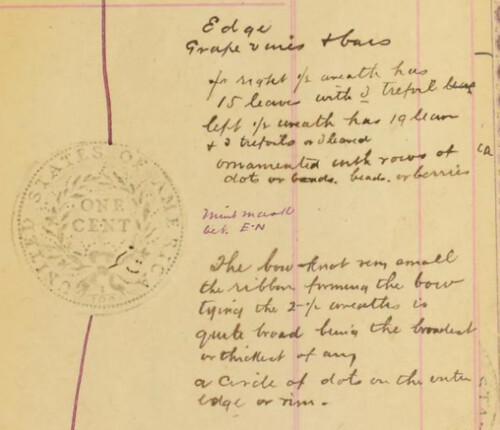
Extract from Levick notebook, reverse of wreath cent.
https://archive.org/details/jntlevicksbookof00levi
https://archive.org/stream/AJN1866Vols01to05#page/n223/mode/2up

WAYNE'S NUMISMATIC DIARY: OCTOBER 30, 2016
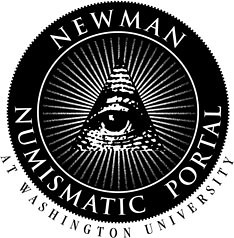 Last Sunday I got up early, walked our dog and drove to Dulles Airport while it was still dark. The sun was beginning to come up while I waited for the shuttle from the parking lot. I was on my way to St. Louis for a meeting of the Newman Numismatic Portal team.
Last Sunday I got up early, walked our dog and drove to Dulles Airport while it was still dark. The sun was beginning to come up while I waited for the shuttle from the parking lot. I was on my way to St. Louis for a meeting of the Newman Numismatic Portal team.
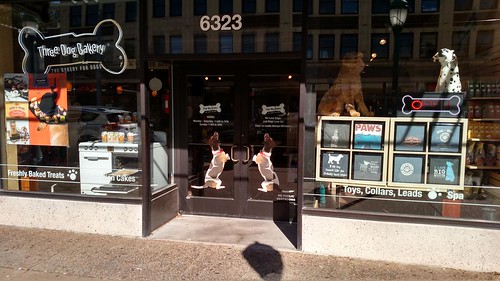
About 5:45 I published The E-Sylum and headed down to the lobby and met NNP Project Coordinator Len Augsburger, who had flown in from Chicago. Soon we were joined by John Feigenbaum and his lead developer Greg Bradley. Len drove us to an upscale seafood restaurant downtown. Eric Newman's son Andy joined us and we were seated at a nice round table for six.
Around 9:30 Monday morning I met Len and John Kraljevich in the lobby. John had flown in from South Carolina earlier that morning and would be joining us for the day. Together with John and Greg we walked across campus to the Olin Library for our meeting.
After lunch came the highlight of my trip - John Feigenbaum and Greg had planes to catch, but Len, JK and I would have a chance to meet with Eric Newman at his home. Andy was already there and welcomed us in. Eric was expecting us, sitting in a comfy electric recliner chair with three recent Whitman coin books on the table in front of him.
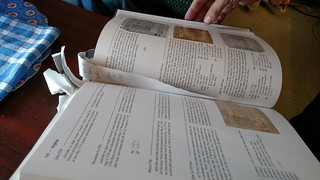 We discussed a possible 6th edition of Eric's Early American Paper Money book. Andy showed us a copy of the 5th edition with Eric's notes.
We discussed a possible 6th edition of Eric's Early American Paper Money book. Andy showed us a copy of the 5th edition with Eric's notes.
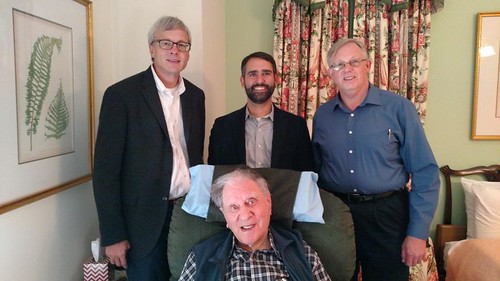
Top: Len Augsburger, John Kraljevich, Wayne Homren
Front: Eric P. Newman at 105 (and a half)!
Our next stop was the Newman Numismatic Portal scanning center, where the equipment from Internet Archive is installed. The scanners are in a small dark room off a main office which is kept locked to protect the rare books often stored there. The office is in a former department store building now owned by the University and used for library offices and storage.
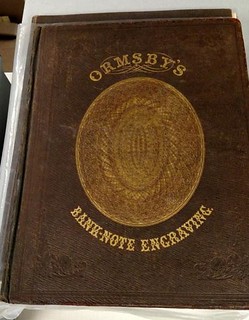
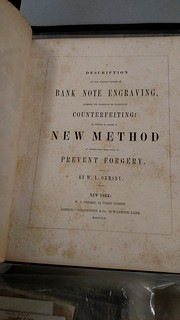
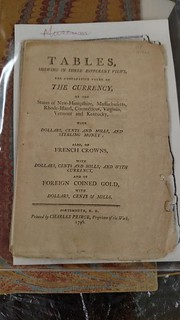
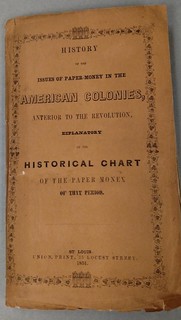
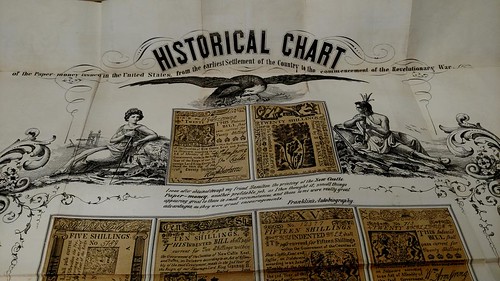
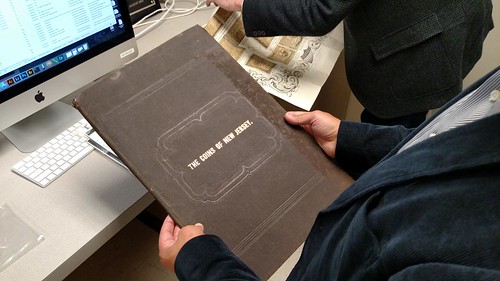
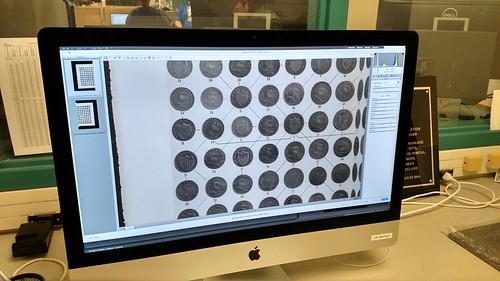
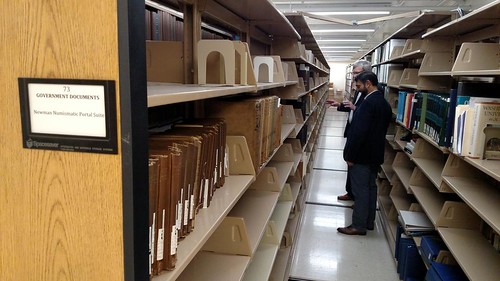
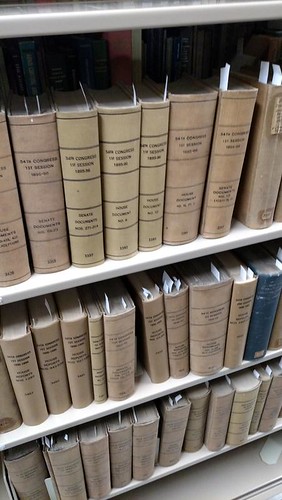 Washington University is a member of the Federal Reserve library system and as such holds a substantial collection of U.S. government documents. Many of these have numismatic content. One of the lesser known examples is the Congressional Serial Set, an 18,000 volume record of congressional proceedings. Washington U. has a complete hard copy of this set and many volumes with numismatic content have been pulled onto the Newman shelves for scanning.
Washington University is a member of the Federal Reserve library system and as such holds a substantial collection of U.S. government documents. Many of these have numismatic content. One of the lesser known examples is the Congressional Serial Set, an 18,000 volume record of congressional proceedings. Washington U. has a complete hard copy of this set and many volumes with numismatic content have been pulled onto the Newman shelves for scanning.
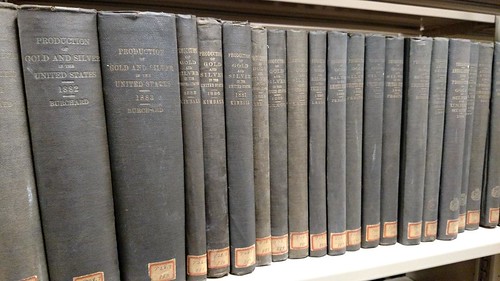
John had a plane to catch, so our visit was a short one.
Len took us both to the airport.
I sat down in a restaurant and drafted some of this diary, not knowing which would come first - dinnertime or a dead battery. The race was a dead heat. I packed up my laptop and had dinner before catching my own plane back to Dulles at 6:30.
THE BOOK BAZARRE
DENNIS HENGEVELD ON NUMISMATIC LITERATURE
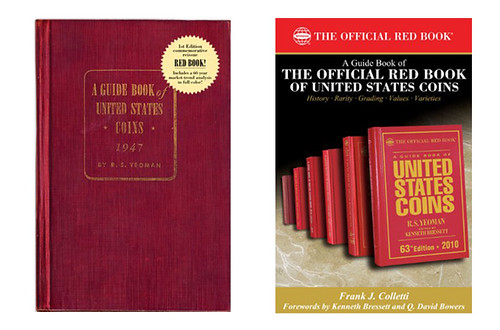
The Red Book “Tribute Edition,” at left, and Frank J. Colletti’s
“Guide Book of the Official Red Book of United States Coins.”
Numismatic Literature
(http://news.coinupdate.com/numismatic-literature/)

NOTES FROM E-SYLUM READERS: OCTOBER 30, 2016
Cole Hendrickson writes:
PLAY “WAIT, WAIT, DON’T TELL ME!”
(www.coinbooks.org/esylum_v19n43a12.html)
Wendell Wolka writes:
Greg Burns writes:
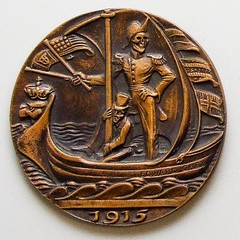
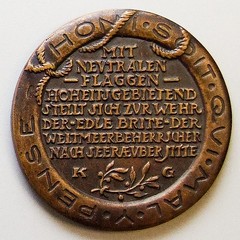
Artist: Karl Goetz, 1875-1950, German, 1875 - 1950
Bronze medal of Abuse of Neutral Flags
(http://artgallery.yale.edu/collections/objects/164807)
NUMISMATIC LETTERS TO GEORGE F. KUNZ
(www.coinbooks.org/esylum_v19n41a20.html)
NOTES FROM E-SYLUM READERS: OCTOBER 16, 2016 :
More on George Kunz
(www.coinbooks.org/esylum_v19n42a06.html)
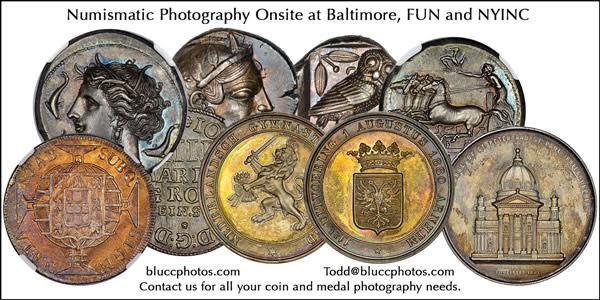
VOCABULARY TERM: PROVING
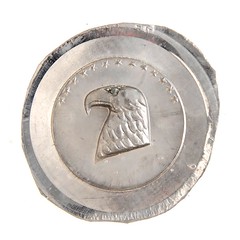
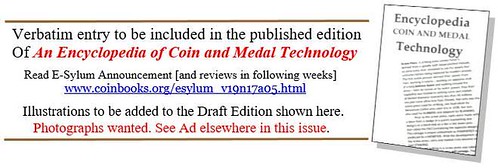
FRANK C. BEREK (1886-?), AKA FRANK BRIGHTER
 Frank C. Berek (1886-?), AKA Frank Brighter was born in Poland 1886, son of German-Poles. When he came to America is uncertain since he also claimed to have been born in South America. He worked as a tailor, photographer, and printer. His area of specialization was Federal Reserve Bank Notes. He liked them so much he began counterfeiting them in Seattle, Washington while in business with his partner Hans Groosli, both men owning a tailing shop. Berek was imprisoned in 1914 in the federal penitentiary on McNeil's Island for counterfeiting $5 and $20 Notes of the Bank of Montreal, Canada. He was released in 1918 and immediately began counterfeiting $100 Federal Reserve Notes of the Bank of Dallas, Texas. He was soon arrested and taken prisoner but escaped on a train en route to McNeil's Island. The Evening Tribune, Saturday, August 10, 1918, page 8 reported :
Frank C. Berek (1886-?), AKA Frank Brighter was born in Poland 1886, son of German-Poles. When he came to America is uncertain since he also claimed to have been born in South America. He worked as a tailor, photographer, and printer. His area of specialization was Federal Reserve Bank Notes. He liked them so much he began counterfeiting them in Seattle, Washington while in business with his partner Hans Groosli, both men owning a tailing shop. Berek was imprisoned in 1914 in the federal penitentiary on McNeil's Island for counterfeiting $5 and $20 Notes of the Bank of Montreal, Canada. He was released in 1918 and immediately began counterfeiting $100 Federal Reserve Notes of the Bank of Dallas, Texas. He was soon arrested and taken prisoner but escaped on a train en route to McNeil's Island. The Evening Tribune, Saturday, August 10, 1918, page 8 reported :
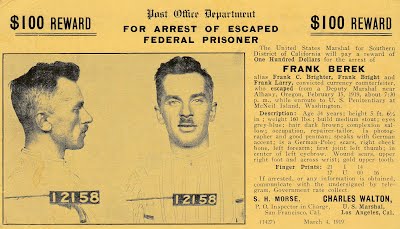
BEREK, FRANK
(www.numismaticmall.com/numismaticmall-com/berek-frank)
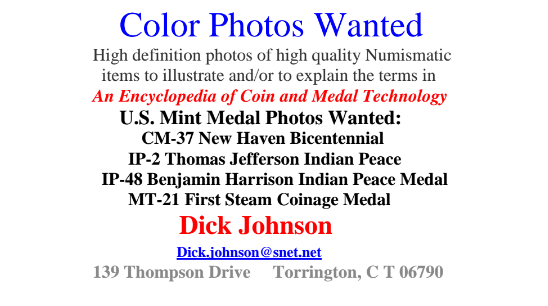
1838-O HALF DOLLAR RESEARCH
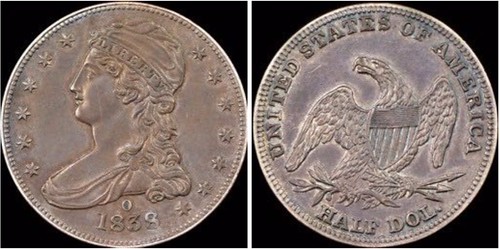
IS THE ONLY SURVIVING ORIGINAL 1838-O HALF DOLLAR
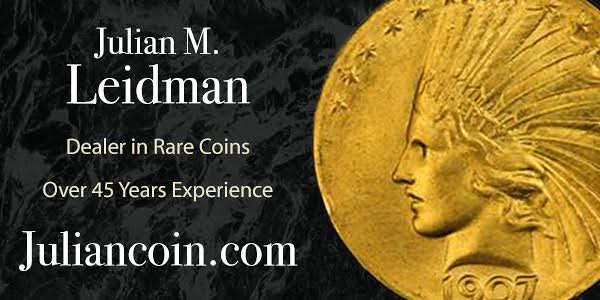
NEIL SHAFER'S COIN SHOP TALES
BEBEE BUYS A BANK BUILDING: COIN SHOPS IN AMERICA
(www.coinbooks.org/esylum_v19n40a19.html)
MORE COIN SHOP TALES
(www.coinbooks.org/esylum_v19n41a13.html)
MORE COIN SHOP TALES
(www.coinbooks.org/esylum_v19n42a09.html)
RUSTY GOE'S SOUTHGATE COINS TO CLOSE
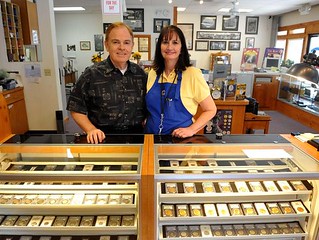 Citing the termination of their lease, the owners of Southgate Coins have decided to close the popular shop they’ve run in Reno since 2001.
Citing the termination of their lease, the owners of Southgate Coins have decided to close the popular shop they’ve run in Reno since 2001.
24
Popular coin shop loses its lease; to close next month
(www.rgj.com/story/news/2016/10/26/popular-coin-shop-loses-lease-close-next-month/92796768/)

CERTIFICATES EXCHANGED FOR SILVER IN 1960S
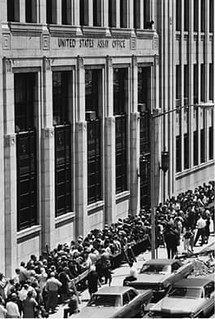 Not everyone reads the “fine print,” but in the mid-1960s, reading and acting on the fine print found on a particular class of U.S. paper money meant big profits for thousands of individuals and businesses.
Not everyone reads the “fine print,” but in the mid-1960s, reading and acting on the fine print found on a particular class of U.S. paper money meant big profits for thousands of individuals and businesses.
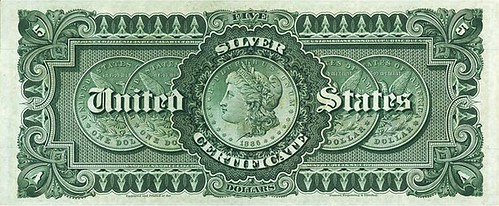
This 1886 Five Dollar Silver Certificate makes the fine print come to life
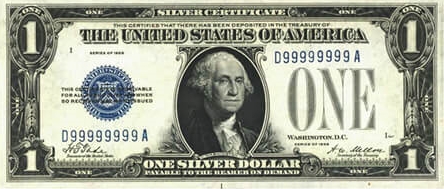
Thankfully this funky serial number note was saved for collectors
Collector alchemy: How paper was turned into silver during four years in the 1960s
(www.coinworld.com/news/paper-money/2016/10/redeeming-silver-certificates-us-paper-money-notes.html)
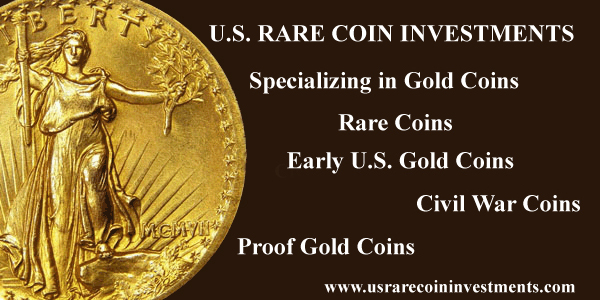
THE BULLION CRISIS OF 2008
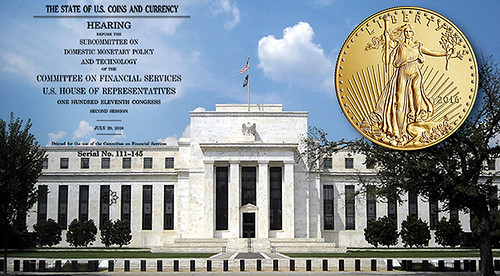
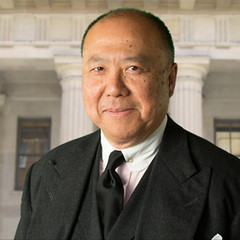 The director is appointed by the president of the United States, by and with the advice and consent of the Senate, while the deputy director is a career civil servant. As director, I was responsible for leading the Mint and accountable to Congress for its performance. There was a traditional division of work: the director, as a political appointee, provided policy direction and had a small team of additional political appointees to help develop policy. The deputy director, as a career civil servant, implemented the policy by running the operations, which were staffed completely by fellow civil servants.
The director is appointed by the president of the United States, by and with the advice and consent of the Senate, while the deputy director is a career civil servant. As director, I was responsible for leading the Mint and accountable to Congress for its performance. There was a traditional division of work: the director, as a political appointee, provided policy direction and had a small team of additional political appointees to help develop policy. The deputy director, as a career civil servant, implemented the policy by running the operations, which were staffed completely by fellow civil servants.
Mint in Crisis: The Inside Story of the Bullion Shortage of 2008, Part 1
(http://mintnewsblog.com/mint-in-crisis-the-inside-story-of-the-bullion-shortage-of-2008-part-1/)
Mint in Crisis: The Inside Story of the Bullion Shortage of 2008, Part 2
(http://mintnewsblog.com/mint-in-crisis-the-inside-story-of-the-bullion-shortage-of-2008-part-2/)
Mint in Crisis: The Inside Story of the Bullion Crisis of 2008, Part 3
(http://mintnewsblog.com/mint-in-crisis-the-inside-story-of-the-bullion-crisis-of-2008-part-3/)
Mint in Crisis: The Inside Story of the Bullion Crisis of 2008, Part 4
(http://mintnewsblog.com/14565-2/)
THE BOOK BAZARRE
PODCAST: PAT HELLER ON MINT AND COIN MARKET
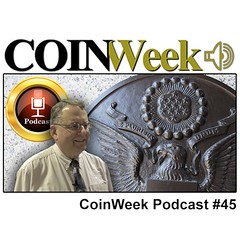 CM: So Pat, the last time I saw you was two weeks ago when we were at the United States Mint’s stakeholder’s forum. What was your takeaway from that event?
CM: So Pat, the last time I saw you was two weeks ago when we were at the United States Mint’s stakeholder’s forum. What was your takeaway from that event?
CoinWeek Podcast #45: Can the U.S. Mint Compete in the Current Coin Climate & The 2016 Election’s Effect on Gold
(www.coinweek.com/coinweek-podcast/u-s-mint-compete-in-the-current-coin-climate/)
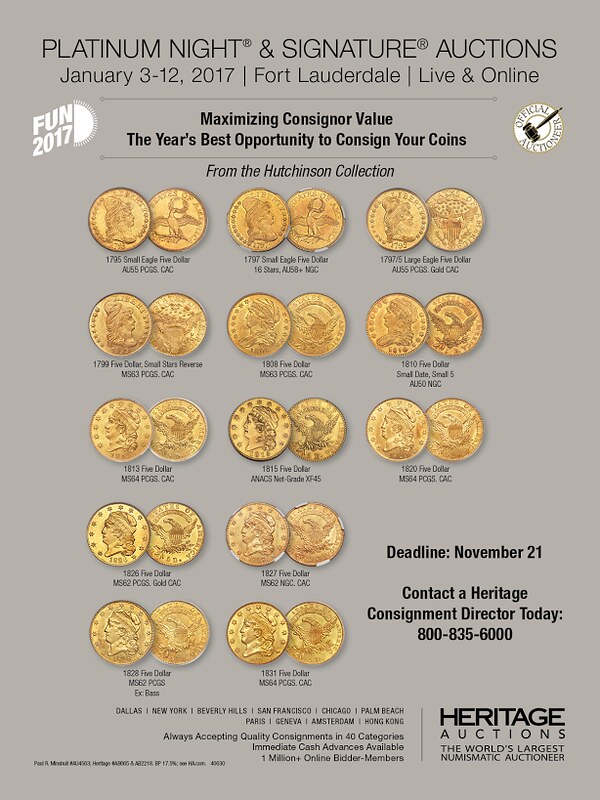
1987 NGC “BLACK LABEL” HOLDER SOLD
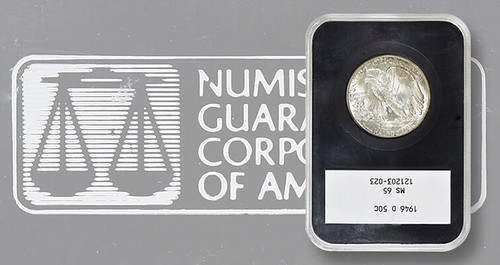
Fancy slab mania: How coin holders have become collectibles
(www.coinworld.com/news/us-coins/2016/10/rare-coin-holders-grading-slabs-pcgs-ngc-numismatic-investment.html)
NEW BOOK: COIN COLLECTING ALBUMS, VOLUME ONE
(www.coinbooks.org/esylum_v16n32a02.html)
NEW BOOK: COIN COLLECTING ALBUMS, VOLUME TWO
(www.coinbooks.org/esylum_v19n11a03.html)
NEW BOOK: SAMPLE SLABS
(www.coinbooks.org/esylum_v18n25a05.html)
NEW BOOK: SAMPLE SLABS, 2ND EDITION
(www.coinbooks.org/esylum_v19n29a04.html)
SLABBING ACID-TREATED DATELESS BUFFALO NICKELS
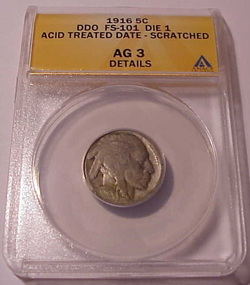 Remember dateless Buffalo nickels?
Remember dateless Buffalo nickels?
Acid date collectible?
(www.numismaticnews.net/article/acid-date-collectible)

COIN COLLECTING AND LOSING VISION
THE BOOK BAZARRE
NATIONAL COLLECTION ACQUIRES IBILL READER
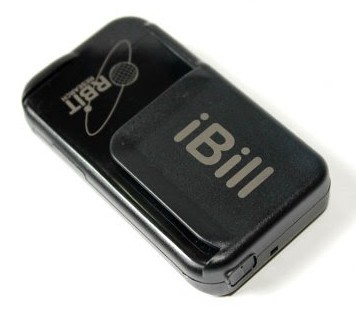 The first innovative object is the iBill Currency Reader—a new technology that helps to make U.S. banknotes more accessible. American banknotes are the same size, weight, and texture regardless of denomination. This uniformity makes it difficult for people who are blind or have low vision to determine the value of their banknotes. In 2015 the U.S. Treasury's Bureau of Engraving and Printing (BEP) established the U.S. Currency Reader Program as part of the Meaningful Access Program. The BEP distributes iBills for free to people who are blind or have low vision.
The first innovative object is the iBill Currency Reader—a new technology that helps to make U.S. banknotes more accessible. American banknotes are the same size, weight, and texture regardless of denomination. This uniformity makes it difficult for people who are blind or have low vision to determine the value of their banknotes. In 2015 the U.S. Treasury's Bureau of Engraving and Printing (BEP) established the U.S. Currency Reader Program as part of the Meaningful Access Program. The BEP distributes iBills for free to people who are blind or have low vision.
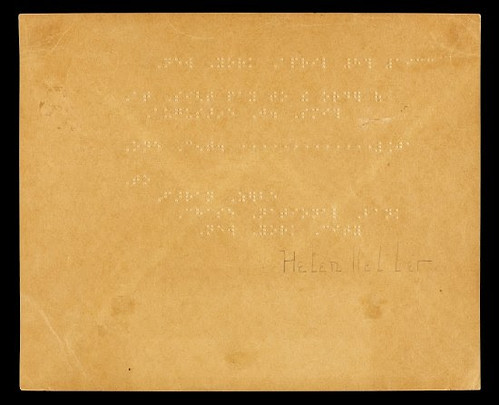
Check for one cent signed by Helen Keller, United States, 1933.
Donated by The Chase Manhattan Bank.
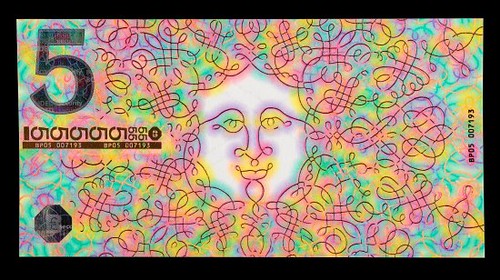
5 Brixton Pound note, United Kingdom, 2014.
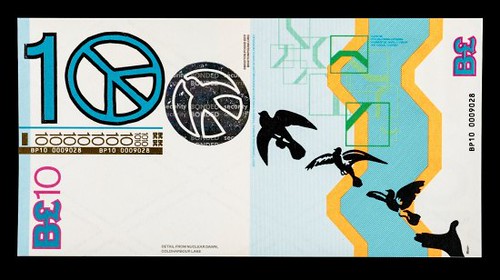
10 Brixton Pound note, United Kingdom, about 2011.
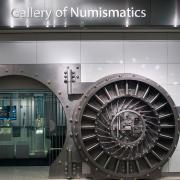 To read the complete article, see:
To read the complete article, see:
What is innovation in money today?
(http://americanhistory.si.edu/blog/innovation-money-today)
http://americanhistory.si.edu/exhibitions/value-money
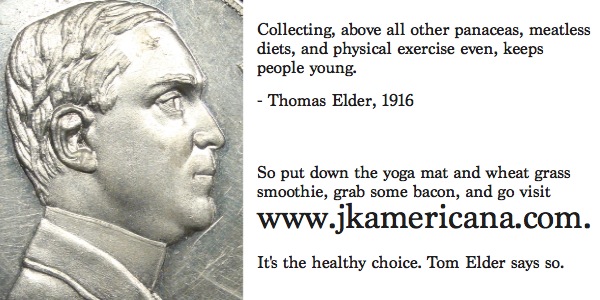
ALTERNATIVE CURRENCIES IN ANCIENT ROMAN WORLD
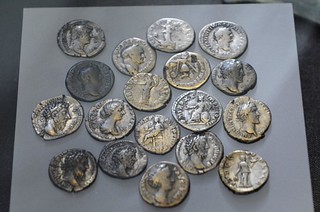 Be it Bristol or Brixton, in recent years a number of cities in Britain have developed their own alternative, local currencies. Intended to support independent businesses, these currencies work alongside pounds sterling to encourage more money to be spent in the local economy. But, as historian Clare Rowan explains, the concept is anything but modern – in fact, alternative currencies date back as far as ancient Rome…
Be it Bristol or Brixton, in recent years a number of cities in Britain have developed their own alternative, local currencies. Intended to support independent businesses, these currencies work alongside pounds sterling to encourage more money to be spent in the local economy. But, as historian Clare Rowan explains, the concept is anything but modern – in fact, alternative currencies date back as far as ancient Rome…
Alternatives to governmental currencies have existed throughout history, including ancient Rome. In the third century BC, Rome introduced a new currency system based around a silver coin called the denarius. The growth of the Roman empire meant that Roman money was used across the Mediterranean – the only currency to be employed across Europe until the introduction of the euro in 1999. Alongside the denarius, local cities might strike their own coins (often small change), which often bore imagery of local cultural significance.
Excavations at Pompeii have revealed that a significant quantity of alternative currencies in the form of small aes (bronze) coins were in use in the city. Indeed, 45 per cent of the coinage found during recent excavations of a tenement was of this kind, which indicates that alternative currency played a prominent role in the city.
From bes to Bitcoin: alternative currencies in the ancient Roman world
(www.historyextra.com/article/bbc-history-magazine/history-alternative-currencies-bes-bitcoin)
WAR AGAINST COLLECTORS OF ANCIENT COINS
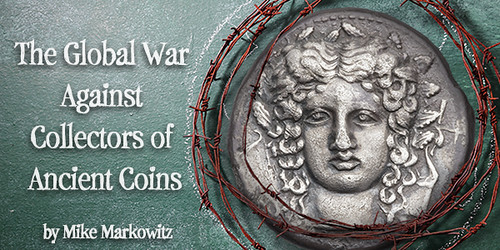
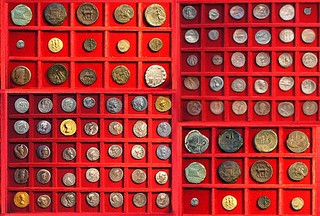 In July 2016 the German Parliament passed the new Cultural Property Protection Act (Kulturgutschutzgesetz), requiring that any antiquity offered for sale be accompanied by a valid export license from the country of origin. Germany has historically been a major player in the ancient coin trade, with many old and internationally respected auction houses. A last minute lobbying campaign by collectors secured an exemption for coins.
In July 2016 the German Parliament passed the new Cultural Property Protection Act (Kulturgutschutzgesetz), requiring that any antiquity offered for sale be accompanied by a valid export license from the country of origin. Germany has historically been a major player in the ancient coin trade, with many old and internationally respected auction houses. A last minute lobbying campaign by collectors secured an exemption for coins.
The Global War Against Collectors of Ancient Coins
(www.coinweek.com/ancient-coins/global-war-collectors-ancient-coins/)
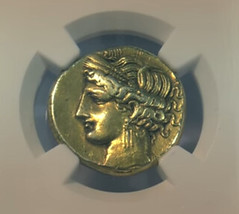 In other content relating to ancient coins, on October 26, 2016 CoinWeek published this video profile of the Carthaginian 1 1/2 Gold and Silver Shekel Coin
-Editor
In other content relating to ancient coins, on October 26, 2016 CoinWeek published this video profile of the Carthaginian 1 1/2 Gold and Silver Shekel Coin
-Editor
CoinWeek Video Coin Profile: The Carthaginian 1 1/2 Gold and Silver Shekel Coin – 4K Video
(www.coinweek.com/ancient-coins/coinweek-video-coin-profile-carthaginian-1-12-gold-silver-shekel-coin-4k-video/)

QUEEN ANNE 'VIGO' GOLD FIVE GUINEA FOUND
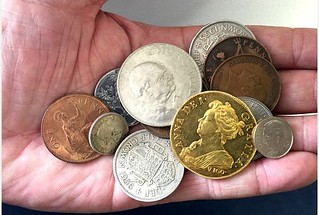 One of Britain's rarest coins will go under the hammer at an Essex auction house next month after being discovered in a little boy's toy box.
One of Britain's rarest coins will go under the hammer at an Essex auction house next month after being discovered in a little boy's toy box.
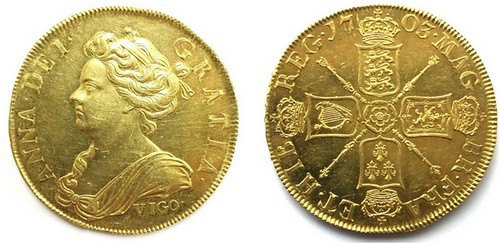
Essex auctioneers to sell rare coin worth up to £250,000 which was found in child's toy box
Read more at http://www.essexlive.news/essex-auctioneers-to-sell-rare-coin-worth-up-to-250-000-which-was-found-in-child-s-toy-box/story-29833793-detail/story.html#1RIRFhoHXIjSKGg6.99
(www.essexlive.news/essex-auctioneers-to-sell-rare-coin-worth-up-to-250-000-which-was-found-in-child-s-toy-box/story-29833793-detail/story.html)
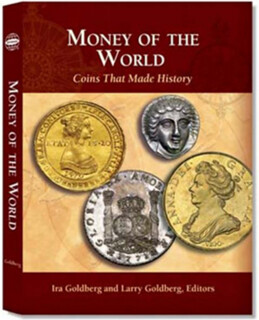 The VIGO 5-guineas gold coin is featured in Ira and Lawrence Goldberg’s Money of the World: Coins That Made History --- in fact, it’s on the book’s cover. The author of chapter 5 (“1600–1750: The Age of Reason?”), Michael J. Shubin, calls the coin one of “two outstanding mementoes of Britain’s mercantilist period and its rise to pre-eminence as a maritime world power.” (The other is the LIMA crown of King George II, struck from Spanish silver captured by Captain George Anson in South America.)
The VIGO 5-guineas gold coin is featured in Ira and Lawrence Goldberg’s Money of the World: Coins That Made History --- in fact, it’s on the book’s cover. The author of chapter 5 (“1600–1750: The Age of Reason?”), Michael J. Shubin, calls the coin one of “two outstanding mementoes of Britain’s mercantilist period and its rise to pre-eminence as a maritime world power.” (The other is the LIMA crown of King George II, struck from Spanish silver captured by Captain George Anson in South America.)
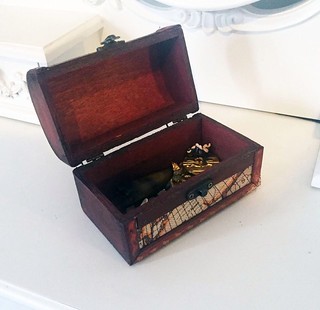
BURIED TREASURE Labourer lands £250,000 windfall after discovering rarest British coin ever made in his four-year-old son’s treasure chest
(www.thesun.co.uk/news/2044202/labourer-lands-250000-windfall-after-discovering-rarest-british-coin-ever-made-in-his-four-year-old-sons-treasure-chest/)

SOVEREIGN RE-CREATES ORIGINAL PISTRUCCI DESIGN
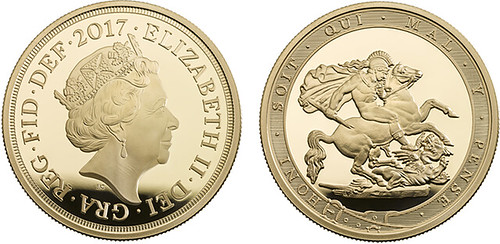
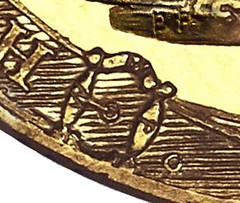 For its 200th anniversary in 2017, the reverse design returns to Pistrucci’s original “garter” design, referencing the garter encircling the field with buckle at lower left. The legend on the garter reads HONI SOIT QUI MAL Y PENSE (“Evil unto him that thinks evil of it”), which is the motto of the British chivalric Order of the Garter.
For its 200th anniversary in 2017, the reverse design returns to Pistrucci’s original “garter” design, referencing the garter encircling the field with buckle at lower left. The legend on the garter reads HONI SOIT QUI MAL Y PENSE (“Evil unto him that thinks evil of it”), which is the motto of the British chivalric Order of the Garter.
United Kingdom: 200 Years of the Iconic Sovereign Celebrated with Re-creation of Original Pistrucci Design
(http://news.coinupdate.com/united-kingdom-200-years-of-the-iconic-sovereign-celebrated-with-re-creation-of-original-pistrucci-design/)
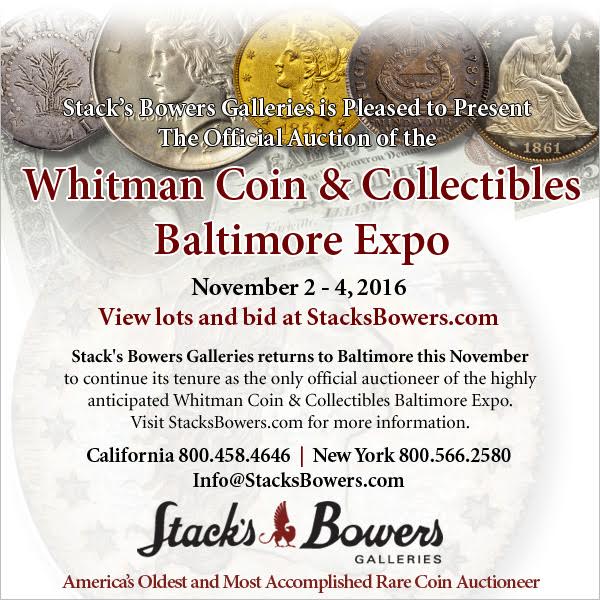
THE DEADWOOD RACKETEER NICKEL
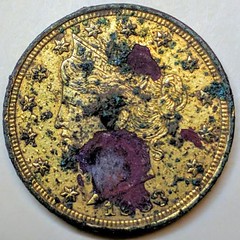 In what is being described as a "Eureka!" moment, numismatists examining a treasure trove of coins unearthed during four years of archeological digs in this Black Hills community have discovered what may be one of the most unusual coins on earth.
In what is being described as a "Eureka!" moment, numismatists examining a treasure trove of coins unearthed during four years of archeological digs in this Black Hills community have discovered what may be one of the most unusual coins on earth.
Eureka moment arises as experts discover rare coin in Deadwood
(http://rapidcityjournal.com/news/local/eureka-moment-arises-as-experts-discover-rare-coin-in-deadwood/article_2b9d6c1d-f31c-5c07-a853-5280c406428a.html)
HUNLEY SUB LUCKY GOLD COIN FOUND
(www.coinbooks.org/esylum_v04n22a05.html)

SELECTED SCOTTISH BANKNOTES FROM PAM WEST
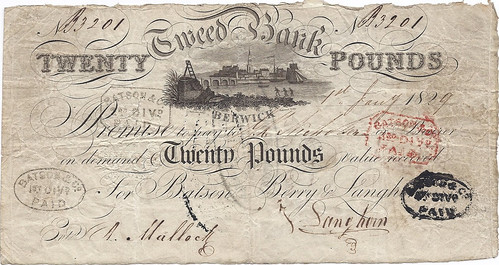
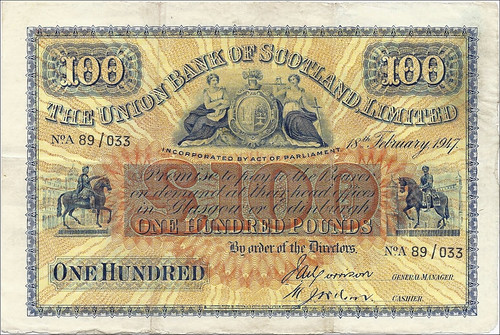
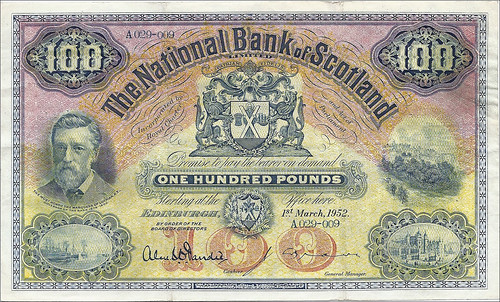
http://britishnotes.co.uk/
POLYMER BANKNOTE INK EASILY ERASED
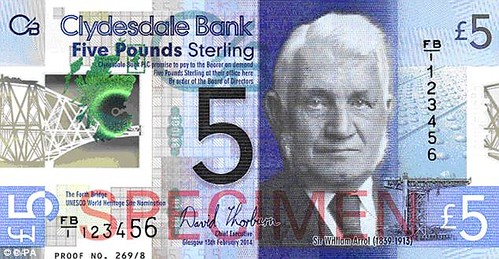
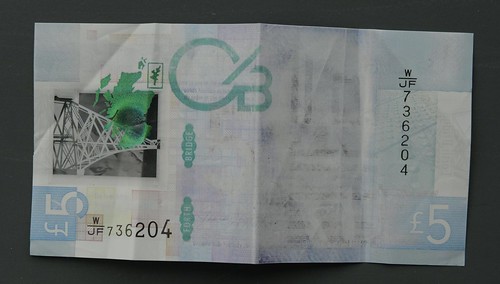
Plastic £5 banknote 'can be rubbed out', says printer
(www.heraldscotland.com/news/14828549.Plastic___5_banknote
___39_can_be_rubbed_out__39___says_printer/?ref=rss#)
Britain's first plastic banknotes enter circulation as Clydesdale Bank issues new fivers - ahead of Bank of England launch in 2016
(www.thisismoney.co.uk/money/news/article-3007780/Clydesdale-Bank-issues-Britain-s-plastic-banknotes.html)
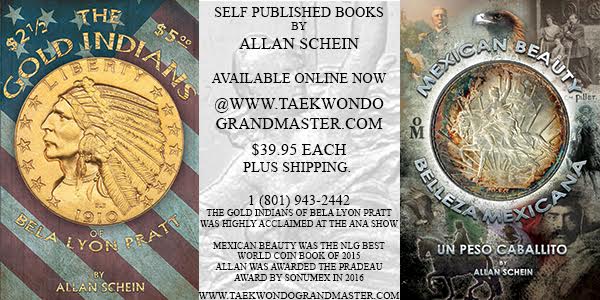
IMAGES OF DENTISTRY ON PAPER MONEY
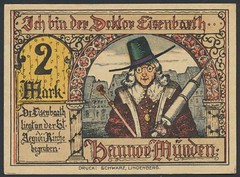
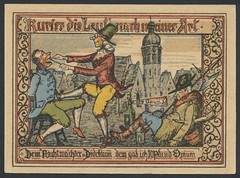
NOTES FROM E-SYLUM READERS: OCTOBER 23, 2016 : Images of Dentistry on Paper Money Sought
(www.coinbooks.org/esylum_v19n43a10.html)
THAI KING'S DEATH BOOSTS NUMISMATIC SALES
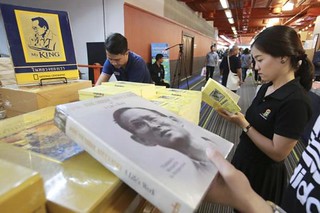 Demand for His Majesty King Bhumibol Adulyadej's memorabilia has surged to an unprecedented level in the past few weeks.
Demand for His Majesty King Bhumibol Adulyadej's memorabilia has surged to an unprecedented level in the past few weeks.
Passion high for King's memorabilia
(www.bangkokpost.com/business/news/1118577/passion-high-for-kings-memorabilia)
VIDEO: TIME-LAPSE RESHELVING AT NYPL
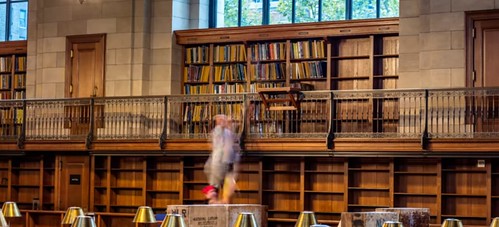
Time Lapse: Thousands of Books Get Reshelved Before the Rose Main Reading Room Reopens
(www.youtube.com/watch?v=tkD9aNOn6v0&feature=youtu.be)
THE ANTHROPODERMIC BOOK PROJECT
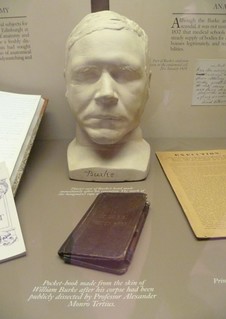 ... talk proliferated about human-skin-bound books, now called anthropodermic bibliopegy. At Le Bal du Zéphir, a legendary (and possibly fictitious) ball held inside a French cemetery, human-skin-bound leaflets of Droits de l’Homme were said to be given out as party favors. To this day books belonging to men like Armand-Jérôme Bignon, librarian to Louis XV, bear inscriptions such as “religatum de pelle humana” or “reliée en peau humaine,” though these are the only possible indicators of their bindings’ disturbing pedigree.
... talk proliferated about human-skin-bound books, now called anthropodermic bibliopegy. At Le Bal du Zéphir, a legendary (and possibly fictitious) ball held inside a French cemetery, human-skin-bound leaflets of Droits de l’Homme were said to be given out as party favors. To this day books belonging to men like Armand-Jérôme Bignon, librarian to Louis XV, bear inscriptions such as “religatum de pelle humana” or “reliée en peau humaine,” though these are the only possible indicators of their bindings’ disturbing pedigree.
A Book by Its Cover:
The strange history of books bound in human skin.
(http://laphamsquarterly.org/roundtable/book-its-cover/)
The Anthropodermic Book Project
(https://anthropodermicbooks.org/)
CREEPY HUMAN-SKIN BOUND BOOK OFFERED
(www.coinbooks.org/esylum_v10n49a29.html)
ON ANTHROPODERMIC BIBLIOPEGY
(www.coinbooks.org/esylum_v10n50a19.html)
MORE BOOKS BOUND IN HUMAN SKIN
(www.coinbooks.org/esylum_v19n18a31.html)
M. L. BEISTLE AND THE BEISTLE COMPANY
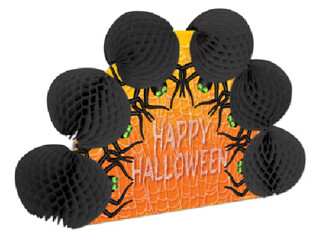
Beistle: An American Halloween Giant
(www.spookshows.com/beistle/beistle.htm)
FEATURED WEB SITE: ORIENTAL NUMISMATIC SOCIETY
This week's Featured Web Site is the Oriental Numismatic Society.
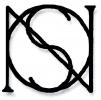
http://orientalnumismaticsociety.org/

